6.1 Overview of Non-Experimental Research
Learning objectives.
- Define non-experimental research, distinguish it clearly from experimental research, and give several examples.
- Explain when a researcher might choose to conduct non-experimental research as opposed to experimental research.

What Is Non-Experimental Research?
Non-experimental research is research that lacks the manipulation of an independent variable. Rather than manipulating an independent variable, researchers conducting non-experimental research simply measure variables as they naturally occur (in the lab or real world).
Most researchers in psychology consider the distinction between experimental and non-experimental research to be an extremely important one. This is because although experimental research can provide strong evidence that changes in an independent variable cause differences in a dependent variable, non-experimental research generally cannot. As we will see, however, this inability to make causal conclusions does not mean that non-experimental research is less important than experimental research.
When to Use Non-Experimental Research
As we saw in the last chapter , experimental research is appropriate when the researcher has a specific research question or hypothesis about a causal relationship between two variables—and it is possible, feasible, and ethical to manipulate the independent variable. It stands to reason, therefore, that non-experimental research is appropriate—even necessary—when these conditions are not met. There are many times in which non-experimental research is preferred, including when:
- the research question or hypothesis relates to a single variable rather than a statistical relationship between two variables (e.g., How accurate are people’s first impressions?).
- the research question pertains to a non-causal statistical relationship between variables (e.g., is there a correlation between verbal intelligence and mathematical intelligence?).
- the research question is about a causal relationship, but the independent variable cannot be manipulated or participants cannot be randomly assigned to conditions or orders of conditions for practical or ethical reasons (e.g., does damage to a person’s hippocampus impair the formation of long-term memory traces?).
- the research question is broad and exploratory, or is about what it is like to have a particular experience (e.g., what is it like to be a working mother diagnosed with depression?).
Again, the choice between the experimental and non-experimental approaches is generally dictated by the nature of the research question. Recall the three goals of science are to describe, to predict, and to explain. If the goal is to explain and the research question pertains to causal relationships, then the experimental approach is typically preferred. If the goal is to describe or to predict, a non-experimental approach will suffice. But the two approaches can also be used to address the same research question in complementary ways. For example, Similarly, after his original study, Milgram conducted experiments to explore the factors that affect obedience. He manipulated several independent variables, such as the distance between the experimenter and the participant, the participant and the confederate, and the location of the study (Milgram, 1974) [1] .
Types of Non-Experimental Research
Non-experimental research falls into three broad categories: cross-sectional research, correlational research, and observational research.
First, cross-sectional research involves comparing two or more pre-existing groups of people. What makes this approach non-experimental is that there is no manipulation of an independent variable and no random assignment of participants to groups. Imagine, for example, that a researcher administers the Rosenberg Self-Esteem Scale to 50 American college students and 50 Japanese college students. Although this “feels” like a between-subjects experiment, it is a cross-sectional study because the researcher did not manipulate the students’ nationalities. As another example, if we wanted to compare the memory test performance of a group of cannabis users with a group of non-users, this would be considered a cross-sectional study because for ethical and practical reasons we would not be able to randomly assign participants to the cannabis user and non-user groups. Rather we would need to compare these pre-existing groups which could introduce a selection bias (the groups may differ in other ways that affect their responses on the dependent variable). For instance, cannabis users are more likely to use more alcohol and other drugs and these differences may account for differences in the dependent variable across groups, rather than cannabis use per se.
Cross-sectional designs are commonly used by developmental psychologists who study aging and by researchers interested in sex differences. Using this design, developmental psychologists compare groups of people of different ages (e.g., young adults spanning from 18-25 years of age versus older adults spanning 60-75 years of age) on various dependent variables (e.g., memory, depression, life satisfaction). Of course, the primary limitation of using this design to study the effects of aging is that differences between the groups other than age may account for differences in the dependent variable. For instance, differences between the groups may reflect the generation that people come from (a cohort effect) rather than a direct effect of age. For this reason, longitudinal studies in which one group of people is followed as they age offer a superior means of studying the effects of aging. Once again, cross-sectional designs are also commonly used to study sex differences. Since researchers cannot practically or ethically manipulate the sex of their participants they must rely on cross-sectional designs to compare groups of men and women on different outcomes (e.g., verbal ability, substance use, depression). Using these designs researchers have discovered that men are more likely than women to suffer from substance abuse problems while women are more likely than men to suffer from depression. But, using this design it is unclear what is causing these differences. So, using this design it is unclear whether these differences are due to environmental factors like socialization or biological factors like hormones?
When researchers use a participant characteristic to create groups (nationality, cannabis use, age, sex), the independent variable is usually referred to as an experimenter-selected independent variable (as opposed to the experimenter-manipulated independent variables used in experimental research). Figure 6.1 shows data from a hypothetical study on the relationship between whether people make a daily list of things to do (a “to-do list”) and stress. Notice that it is unclear whether this is an experiment or a cross-sectional study because it is unclear whether the independent variable was manipulated by the researcher or simply selected by the researcher. If the researcher randomly assigned some participants to make daily to-do lists and others not to, then the independent variable was experimenter-manipulated and it is a true experiment. If the researcher simply asked participants whether they made daily to-do lists or not, then the independent variable it is experimenter-selected and the study is cross-sectional. The distinction is important because if the study was an experiment, then it could be concluded that making the daily to-do lists reduced participants’ stress. But if it was a cross-sectional study, it could only be concluded that these variables are statistically related. Perhaps being stressed has a negative effect on people’s ability to plan ahead. Or perhaps people who are more conscientious are more likely to make to-do lists and less likely to be stressed. The crucial point is that what defines a study as experimental or cross-sectional l is not the variables being studied, nor whether the variables are quantitative or categorical, nor the type of graph or statistics used to analyze the data. It is how the study is conducted.
Figure 6.1 Results of a Hypothetical Study on Whether People Who Make Daily To-Do Lists Experience Less Stress Than People Who Do Not Make Such Lists
Second, the most common type of non-experimental research conducted in Psychology is correlational research. Correlational research is considered non-experimental because it focuses on the statistical relationship between two variables but does not include the manipulation of an independent variable. More specifically, in correlational research , the researcher measures two continuous variables with little or no attempt to control extraneous variables and then assesses the relationship between them. As an example, a researcher interested in the relationship between self-esteem and school achievement could collect data on students’ self-esteem and their GPAs to see if the two variables are statistically related. Correlational research is very similar to cross-sectional research, and sometimes these terms are used interchangeably. The distinction that will be made in this book is that, rather than comparing two or more pre-existing groups of people as is done with cross-sectional research, correlational research involves correlating two continuous variables (groups are not formed and compared).
Third, observational research is non-experimental because it focuses on making observations of behavior in a natural or laboratory setting without manipulating anything. Milgram’s original obedience study was non-experimental in this way. He was primarily interested in the extent to which participants obeyed the researcher when he told them to shock the confederate and he observed all participants performing the same task under the same conditions. The study by Loftus and Pickrell described at the beginning of this chapter is also a good example of observational research. The variable was whether participants “remembered” having experienced mildly traumatic childhood events (e.g., getting lost in a shopping mall) that they had not actually experienced but that the researchers asked them about repeatedly. In this particular study, nearly a third of the participants “remembered” at least one event. (As with Milgram’s original study, this study inspired several later experiments on the factors that affect false memories.
The types of research we have discussed so far are all quantitative, referring to the fact that the data consist of numbers that are analyzed using statistical techniques. But as you will learn in this chapter, many observational research studies are more qualitative in nature. In qualitative research , the data are usually nonnumerical and therefore cannot be analyzed using statistical techniques. Rosenhan’s observational study of the experience of people in a psychiatric ward was primarily qualitative. The data were the notes taken by the “pseudopatients”—the people pretending to have heard voices—along with their hospital records. Rosenhan’s analysis consists mainly of a written description of the experiences of the pseudopatients, supported by several concrete examples. To illustrate the hospital staff’s tendency to “depersonalize” their patients, he noted, “Upon being admitted, I and other pseudopatients took the initial physical examinations in a semi-public room, where staff members went about their own business as if we were not there” (Rosenhan, 1973, p. 256) [2] . Qualitative data has a separate set of analysis tools depending on the research question. For example, thematic analysis would focus on themes that emerge in the data or conversation analysis would focus on the way the words were said in an interview or focus group.
Internal Validity Revisited
Recall that internal validity is the extent to which the design of a study supports the conclusion that changes in the independent variable caused any observed differences in the dependent variable. Figure 6.2 shows how experimental, quasi-experimental, and non-experimental (correlational) research vary in terms of internal validity. Experimental research tends to be highest in internal validity because the use of manipulation (of the independent variable) and control (of extraneous variables) help to rule out alternative explanations for the observed relationships. If the average score on the dependent variable in an experiment differs across conditions, it is quite likely that the independent variable is responsible for that difference. Non-experimental (correlational) research is lowest in internal validity because these designs fail to use manipulation or control. Quasi-experimental research (which will be described in more detail in a subsequent chapter) is in the middle because it contains some, but not all, of the features of a true experiment. For instance, it may fail to use random assignment to assign participants to groups or fail to use counterbalancing to control for potential order effects. Imagine, for example, that a researcher finds two similar schools, starts an anti-bullying program in one, and then finds fewer bullying incidents in that “treatment school” than in the “control school.” While a comparison is being made with a control condition, the lack of random assignment of children to schools could still mean that students in the treatment school differed from students in the control school in some other way that could explain the difference in bullying (e.g., there may be a selection effect).

Figure 6.2 Internal Validity of Correlation, Quasi-Experimental, and Experimental Studies. Experiments are generally high in internal validity, quasi-experiments lower, and correlation studies lower still.
Notice also in Figure 6.2 that there is some overlap in the internal validity of experiments, quasi-experiments, and correlational studies. For example, a poorly designed experiment that includes many confounding variables can be lower in internal validity than a well-designed quasi-experiment with no obvious confounding variables. Internal validity is also only one of several validities that one might consider, as noted in Chapter 5.
Key Takeaways
- Non-experimental research is research that lacks the manipulation of an independent variable.
- There are two broad types of non-experimental research. Correlational research that focuses on statistical relationships between variables that are measured but not manipulated, and observational research in which participants are observed and their behavior is recorded without the researcher interfering or manipulating any variables.
- In general, experimental research is high in internal validity, correlational research is low in internal validity, and quasi-experimental research is in between.
- A researcher conducts detailed interviews with unmarried teenage fathers to learn about how they feel and what they think about their role as fathers and summarizes their feelings in a written narrative.
- A researcher measures the impulsivity of a large sample of drivers and looks at the statistical relationship between this variable and the number of traffic tickets the drivers have received.
- A researcher randomly assigns patients with low back pain either to a treatment involving hypnosis or to a treatment involving exercise. She then measures their level of low back pain after 3 months.
- A college instructor gives weekly quizzes to students in one section of his course but no weekly quizzes to students in another section to see whether this has an effect on their test performance.
- Milgram, S. (1974). Obedience to authority: An experimental view . New York, NY: Harper & Row. ↵
- Rosenhan, D. L. (1973). On being sane in insane places. Science, 179 , 250–258. ↵

Share This Book
- Increase Font Size
- Skip to main content
- Skip to primary sidebar
- Skip to footer
- QuestionPro

- Solutions Industries Gaming Automotive Sports and events Education Government Travel & Hospitality Financial Services Healthcare Cannabis Technology Use Case AskWhy Communities Audience Contactless surveys Mobile LivePolls Member Experience GDPR Positive People Science 360 Feedback Surveys
- Resources Blog eBooks Survey Templates Case Studies Training Help center
Home Market Research
Non-experimental research: What it is, overview & advantages

Non-experimental research is the type of research that lacks an independent variable. Instead, the researcher observes the context in which the phenomenon occurs and analyzes it to obtain information.
Unlike experimental research , where the variables are held constant, non-experimental research happens during the study when the researcher cannot control, manipulate or alter the subjects but relies on interpretation or observations to conclude.
This means that the method must not rely on correlations, surveys , or case studies and cannot demonstrate an actual cause and effect relationship.
Characteristics of non-experimental research
Some of the essential characteristics of non-experimental research are necessary for the final results. Let’s talk about them to identify the most critical parts of them.

- Most studies are based on events that occurred previously and are analyzed later.
- In this method, controlled experiments are not performed for reasons such as ethics or morality.
- No study samples are created; on the contrary, the samples or participants already exist and develop in their environment.
- The researcher does not intervene directly in the environment of the sample.
- This method studies the phenomena exactly as they occurred.
Types of non-experimental research
Non-experimental research can take the following forms:
Cross-sectional research : Cross-sectional research is used to observe and analyze the exact time of the research to cover various study groups or samples. This type of research is divided into:
- Descriptive: When values are observed where one or more variables are presented.
- Causal: It is responsible for explaining the reasons and relationship that exists between variables in a given time.
Longitudinal research: In a longitudinal study , researchers aim to analyze the changes and development of the relationships between variables over time. Longitudinal research can be divided into:
- Trend: When they study the changes faced by the study group in general.
- Group evolution: When the study group is a smaller sample.
- Panel: It is in charge of analyzing individual and group changes to discover the factor that produces them.
LEARN ABOUT: Quasi-experimental Research
When to use non-experimental research
Non-experimental research can be applied in the following ways:
- When the research question may be about one variable rather than a statistical relationship about two variables.
- There is a non-causal statistical relationship between variables in the research question.
- The research question has a causal research relationship, but the independent variable cannot be manipulated.
- In exploratory or broad research where a particular experience is confronted.
Advantages and disadvantages
Some advantages of non-experimental research are:
- It is very flexible during the research process
- The cause of the phenomenon is known, and the effect it has is investigated.
- The researcher can define the characteristics of the study group.
Among the disadvantages of non-experimental research are:
- The groups are not representative of the entire population.
- Errors in the methodology may occur, leading to research biases .
Non-experimental research is based on the observation of phenomena in their natural environment. In this way, they can be studied later to reach a conclusion.
Difference between experimental and non-experimental research
Experimental research involves changing variables and randomly assigning conditions to participants. As it can determine the cause, experimental research designs are used for research in medicine, biology, and social science.
Experimental research designs have strict standards for control and establishing validity. Although they may need many resources, they can lead to very interesting results.
Non-experimental research, on the other hand, is usually descriptive or correlational without any explicit changes done by the researcher. You simply describe the situation as it is, or describe a relationship between variables. Without any control, it is difficult to determine causal effects. The validity remains a concern in this type of research. However, it’s’ more regarding the measurements instead of the effects.
LEARN MORE: Descriptive Research vs Correlational Research
Whether you should choose experimental research or non-experimental research design depends on your goals and resources. If you need any help with how to conduct research and collect relevant data, or have queries regarding the best approach for your research goals, contact us today! You can create an account with our survey software and avail of 88+ features including dashboard and reporting for free.
Create a free account
MORE LIKE THIS

2024 QuestionPro Workforce Year in Review
Dec 23, 2024

QuestionPro Workforce Has All The Feels – Release of the New Sentiment Analysis
Dec 19, 2024

The Impact Of Synthetic Data On Modern Research

Companies are losing $ billions with gaps in market research – are you?
Dec 18, 2024
Other categories
- Academic Research
- Artificial Intelligence
- Assessments
- Brand Awareness
- Case Studies
- Communities
- Consumer Insights
- Customer effort score
- Customer Engagement
- Customer Experience
- Customer Loyalty
- Customer Research
- Customer Satisfaction
- Employee Benefits
- Employee Engagement
- Employee Retention
- Friday Five
- General Data Protection Regulation
- Insights Hub
- Life@QuestionPro
- Market Research
- Mobile diaries
- Mobile Surveys
- New Features
- Online Communities
- Question Types
- Questionnaire
- QuestionPro Products
- Release Notes
- Research Tools and Apps
- Revenue at Risk
- Survey Templates
- Training Tips
- Tuesday CX Thoughts (TCXT)
- Uncategorized
- What’s Coming Up
- Workforce Intelligence

Quantitative Research with Nonexperimental Designs
by Janet Salmons, PhD Manager, Sage Research Methods Community
What is the difference between experimental and non-experimental research designs?
There are two types of quantitative research designs: experimental and nonexperimental. This introduction draws from The SAGE Encyclopedia of Educational Research, Measurement, and Evaluation . Leung and Shek (2018) explain:
Experimental research design utilizes the principle of manipulation of the independent variables and examines its cause-and-effect relationship on the dependent variables by controlling the effects of other variables. Usually, the experimenter assigns two or more groups with similar characteristics. Different interventions will be given to the groups. In case there are differences in the outcomes among the groups, the experimenter can conclude that the differences result from the interventions that the experimenter performed. [Learn more about experimental design in an earlier Sage Research Methods Community post, Quantitative Research with Experimental Designs . ] Nonexperimental research designs examine social phenomena without direct manipulation of the conditions that subjects experience. Subjects are not randomly assigned to different groups. As such, evidence that supports the cause-and-effect relationships is largely limited.
There are two main types of nonexperimental research designs: comparative design and correlational design.
In comparative research, the researcher examines the differences between two or more groups on the phenomenon that is being studied. For example, studying gender difference in learning mathematics is a comparative research.
The correlational design is a study of relationships between two or more constructs. A positive correlation means that high values of a variable are associated with high values of another variable. For instance, academic performance of students is positively related to their self-esteem. On the contrary, a negative correlation means that high values of a variable are associated with low values of the other variable. For example, teacher–student conflicts are negatively related to the students’ sense of belonging to the school.
See how researchers use non-experimental research design in this multidisciplinary collection of open-access articles.
Open Access Comparative Studies
Humprecht, E., Hellmueller, L., & Lischka, J. A. (2020). Hostile Emotions in News Comments: A Cross-National Analysis of Facebook Discussions . Social Media + Society . https://doi.org/10.1177/2056305120912481
Abstract. Recent work demonstrates that hostile emotions can contribute to a strong polarization of political discussion on social media. However, little is known regarding the extent to which media organizations and media systems trigger hostile emotions. We content-analyzed comments on Facebook pages from six news organizations ( N = 1,800) based in the United States and Germany. Our results indicate that German news organizations’ Facebook comments are more balanced, containing lower levels of hostile emotions. Such emotions are particularly prevalent in the polarized information environment of the United States—in both news posts and comments. Moreover, alternative right-wing media outlets in both countries provoke significantly higher levels of hostile emotions, thus limiting deliberative discussions. Our results demonstrate that the application of technology—such as the use of comment sections—has different implications depending on cultural and social contexts.
Huang, J., Kumar, S., & Hu, C. (2020). Does Culture Matter? A Comparative Study on the Motivations for Online Identity Reconstruction Between China and Malaysia . SAGE Open . https://doi.org/10.1177/2158244020929311
Abstract. On social network platforms, people may reconstruct an identity due to various reasons, such as vanity, disinhibition, bridging social capital, and privacy concerns. This study aims to identify cultural differences in the motivations for online identity reconstruction between China and Malaysia. Data were collected from China and Malaysia using an online survey. A total of 815 respondents (418 Chinese and 397 Malaysians) participated in this study. Differences were found not only between Chinese and Malaysian participants but also among participants from different ethnic groups (e.g., the Malaysian-Malays and the Malaysian-Chinese). This study adds knowledge to the research concerning online identity reconstruction by taking into account national culture. It also extends the cross-cultural research concerning social network platforms and sheds light on the specific differences between Chinese and Malaysian participants. The findings of this study can help service providers to deploy specific strategies to better serve social network platform users from different countries.
Kalogeropoulos, A., Negredo, S., Picone, I., & Nielsen, R. K. (2017). Who Shares and Comments on News?: A Cross-National Comparative Analysis of Online and Social Media Participation . Social Media + Society. https://doi.org/10.1177/2056305117735754
Abstract. In this article, we present a cross-national comparative analysis of which online news users in practice engage with the participatory potential for sharing and commenting on news afforded by interactive features in news websites and social media technologies across a strategic sample of six different countries. Based on data from the 2016 Reuters Institute Digital News Report, and controlling for a range of factors, we find that (1) people who use social media for news and a high number of different social media platforms are more likely to also engage more actively with news outside social media by commenting on news sites and sharing news via email, (2) political partisans on both sides are more likely to engage in sharing and commenting particularly on news stories in social media, and (3) people with high interest in hard news are more likely to comment on news on both news sites and social media and share stores via social media (and people with high interest in any kind of news [hard or soft] are more likely to share stories via email). Our analysis suggests that the online environment reinforces some long-standing inequalities in participation while countering other long-standing inequalities. The findings indicate a self-reinforcing positive spiral where the already motivated are more likely in practice to engage with the potential for participation offered by digital media, and a negative spiral where those who are less engaged participate less.
Phillips, M., & Smith, D. P. (2018). Comparative approaches to gentrification: Lessons from the rural . Dialogues in Human Geography , 8 (1), 3–25. https://doi.org/10.1177/2043820617752009
Abstract. The epistemologies and politics of comparative research are prominently debated within urban studies, with ‘comparative urbanism’ emerging as a contemporary lexicon of urban studies. The study of urban gentrification has, after some delay, come to engage with these debates, which can be seen to pose a major challenge to the very concept of gentrification. To date, similar debates or developments have not unfolded within the study of rural gentrification. This article seeks to address some of the challenges posed to gentrification studies through an examination of strategies of comparison and how they might be employed within a comparative study of rural gentrification. Drawing on Tilly ( Big structures Large Processes Huge Comparisons . New York: Russell Sage), examples of four ‘strategies of comparison’ are identified within studies of urban and rural gentrification, before the paper explores how ‘geographies of the concept’ and ‘geographies of the phenomenon’ of rural gentrification in the United Kingdom, United States and France may be investigated using Latour’s ( Pandora’s Hope . London: Harvard University Press) notion of ‘circulatory sociologies of translation’. The aim of our comparative discussion is to open up dialogues on the challenges of comparative studies that employ conceptions of gentrification and also to promote reflections of the metrocentricity of recent discussions of comparative research.
Yaşar, H., & Sağsan, M. (2020). The Mediating Effect of Organizational Stress on Organizational Culture and Time Management: A Comparative Study With Two Universities. SAGE Open . https://doi.org/10.1177/2158244020919507
Abstract. This research was designed to investigate whether organizational stress had an intermediary role in the effect of Hofstede cultural dimensions on time management. Near East University from Cyprus, which represents the individual culture, and Hakkari University from Turkey representing the collectivist culture were selected for the research analyses. In all, 638 administrative and academic members from both universities were interviewed face-to-face on a voluntary basis, and data were collected by the simple random sampling method. The research findings suggest that time should be managed after identifying the type of culture—individualistic or collectivist—to decrease the level of stress experienced by university staff. In other words, Hofstede’s cultural dimension has an impact on time management, and organizational stress has a partial mediation effect on this dimension. Although the variables in the study have been studied in the literature together with many different factors, Hofstede is significant in terms of determining the role of organizational stress in the effect of cultural dimensions on time management. The effectiveness of Hofstede’s cultural dimensions through organizational stress in time management allows business and project plans to be carried out in a way that manages individual, team or departmental performances taking into account the organizational stress elements. It is considered that this study will particularly be effective in medicine, project management, and independent auditing.
Open Access Correlational Studies
Adams, R. V., & Blair, E. (2019). Impact of Time Management Behaviors on Undergraduate Engineering Students’ Performance . SAGE Open. https://doi.org/10.1177/2158244018824506
Abstract. Effective time management is associated with greater academic performance and lower levels of anxiety in students; however many students find it hard to find a balance between their studies and their day-to-day lives. This article examines the self-reported time management behaviors of undergraduate engineering students using the Time Management Behavior Scale. Correlation analysis, regression analysis, and model reduction are used to attempt to determine which aspects of time management the students practiced, which time management behaviors were more strongly associated with higher grades within the program, and whether or not those students who self-identified with specific time management behaviors achieved better grades in the program. It was found that students’ perceived control of time was the factor that correlated significantly with cumulative grade point average. On average, it was found that time management behaviors were not significantly different across gender, age, entry qualification, and time already spent in the program.
Cooper, B., & Glaesser, J. (2010). Contrasting Variable-Analytic and Case-Based Approaches to the Analysis of Survey Datasets: Exploring How Achievement Varies by Ability across Configurations of Social Class and Sex. Methodological Innovations Online, 5(1), 3–23. https://doi.org/10.4256/mio.2010.0007
Abstract. The context for this paper is the ongoing debate concerning the relative merits, for the analysis of quantitative data, of, on the one hand, variable-analytic correlational methods, and, on the other, the case-based set theoretic methods developed by Charles Ragin. While correlational approaches, based in linear algebra, typically use regression to establish the net effects of several “independent” variables on an outcome, the set theoretic approach analyses, more holistically, the conjunctions of factors sufficient and/or necessary for an outcome to occur. Here, in order to bring out key differences between the approaches, we focus our attention on the basic building blocks of the two approaches: respectively, the concept of linear correlation and the concept of a sufficient and/or necessary condition. We initially use invented data (for ability, educational achievement, and social class) to simulate what is at stake in this methodological debate and we then employ data taken from the British National Child Development Study to explore the structuring of the relationship between respondents' early measured ability and later educational achievement across various configurations of parental and grandparental class origin and sex. The substantive idea informing the analysis, derived from Boudon's work, is that, for respondents from higher class origins, ability will tend to be sufficient but not necessary for later educational achievement while, for lower class respondents, ability will tend to be necessary but not sufficient. We compare correlational analyses, controlling for class and gender, with fuzzy set analyses to show that set theoretic indices can better capture these varying relationships than correlational measures. In conclusion, we briefly consider how our demonstration of some of the advantages of the set theoretic approach for modelling empirical relationships might be related to the debate concerning the relation between observed regularities and causal mechanisms.
Fang, C., Gai, Q., He, C., & Shi, Q. (2020). The Experience of Poverty Reduction in Rural China. SAGE Open. https://doi.org/10.1177/2158244020982288
Abstract. Since 1978, China has greatly reduced the rural poverty rate. This article provides an overview of the experience of China’s poverty reduction. Using panel data from 1996 to 2013 to calculate farmers’ income dynamics, we found that the pace of poverty reduction was relatively slow from 1996 to 2002 and that the rate of reversion to poverty was high. Since 2003, the pace of poverty reduction has accelerated, whereas the rate of reversion has decreased. Using econometric ordinary least squares and probit models, we explore the factors that drive poverty reduction. We found correlational evidence that the main reasons for poverty reduction in China since 1996 have been the increase in income from household farms and migrant work. In addition, rural public insurance prevented farmers from falling into poverty.
Hayn-Leichsenring, G. U., Lehmann, T., & Redies, C. (2017). Subjective Ratings of Beauty and Aesthetics: Correlations With Statistical Image Properties in Western Oil Paintings . I-Perception. https://doi.org/10.1177/2041669517715474
Abstract. For centuries, oil paintings have been a major segment of the visual arts. The JenAesthetics data set consists of a large number of high-quality images of oil paintings of Western provenance from different art periods. With this database, we studied the relationship between objective image measures and subjective evaluations of the images, especially evaluations on aesthetics (defined as artistic value) and beauty (defined as individual liking). The objective measures represented low-level statistical image properties that have been associated with aesthetic value in previous research. Subjective rating scores on aesthetics and beauty correlated not only with each other but also with different combinations of the objective measures. Furthermore, we found that paintings from different art periods vary with regard to the objective measures, that is, they exhibit specific patterns of statistical image properties. In addition, clusters of participants preferred different combinations of these properties. In conclusion, the results of the present study provide evidence that statistical image properties vary between art periods and subject matters and, in addition, they correlate with the subjective evaluation of paintings by the participants.
Srinivasan P, Rentala S, Kumar P. Impulsivity and Aggression Among Male Delinquent Adolescents Residing in Observation Homes—A Descriptive Correlation Study from East India . Journal of Indian Association for Child and Adolescent Mental Health . 2022;18(4):327-336. doi: 10.1177/09731342231171305
Aggression and crime are connected and highly reported among juveniles in recent times as compared to adults, which ends up in delinquency. It is not just aggression that dominates but the associated impulsiveness also plays a vital role. This study was intended to assess impulsivity and aggression, and their relationship among male delinquent adolescents residing in observation homes. A quantitative research approach with the nonexperimental descriptive correlation design was adopted. One hundred and seventy-nine male delinquent adolescents residing in 2 observation homes in the state of Bihar, India, were selected by convenience sampling technique. The standardized Buss & Perry Aggression questionnaire, and Barratt Impulsiveness scale were used for collecting the data regarding impulsivity and aggression among male delinquent adolescents.
Yamak, O. U., & Eyupoglu, S. Z. (2021). Authentic Leadership and Service Innovative Behavior: Mediating Role of Proactive Personality . SAGE Open. https://doi.org/10.1177/2158244021989629
Abstract. The present study aims to examine the effect of authentic leadership (AL) on service innovative behavior (SIB) of employees as well as to identify whether proactive personality (PP) mediates this connection at an individual level. The quantitative cross-sectional study design was utilized to gather information from a study sample which consisted of 428 front-line employees (FLE) working at banks located in North Cyprus. Specifically, the study uses confirmatory factor analysis (CFA), correlation, structural equation modeling (SEM), and bootstrapping techniques to test the hypothesized relationships. The results reveal that both AL and PP have a significant positive effect on SIB; AL has a positive impact on PP of FLE, and PP plays a partial mediating role between AL and SIB of FLE. By relating the study findings, authenticity and proactivity in the banking sector in North Cyprus play a critical role in fostering the innovative behaviors of FLE. The study also discusses the practical and managerial implications, as well as the future scope.
Books about Quantitative Methods from Sage Publishing
Use the code COMMUNITY3 for a 20% discount when you order her book, valid worldwide until March 31, 2024.
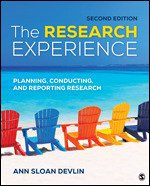
The Research Experience: Planning, Conducting, and Reporting Research by Ann Sloan Devlin (2020). (See Sage Research Methods Community posts by Dr. Devlin.)
Understanding Quantitative Data in Educational Research by Nicoleta Gaciu (2021).
Essentials of Social Statistics for a Diverse Society by Anna Leon-Guerrero, Chava Frankfort-Nachmias, and Georgiann Davis.(2020). (See an author interview for more on this book.)
Understanding Correlation Matrices by Alexandria Hadd and Joseph Lee Rodgers (2021)
Know Your Variables: Little Quick Fix and other titles in the LQF series by John MacInnes
Research Methods for the Behavioral Sciences by Gregory J. Privitera (2022)
Reference Frey, B. (2018). The SAGE encyclopedia of educational research, measurement, and evaluation (Vols. 1-4). Thousand Oaks,, CA: SAGE Publications, Inc. doi: 10.4135/9781506326139
More posts about quantitative research methods

Sample a selection of the most helpful methods videos and guides published in 2024 on the Sage Research Methods online platform with free access.

Listen to this interview, and check out Rhys Jones’ latest book: Statistical Literacy: A Beginner's Guide.
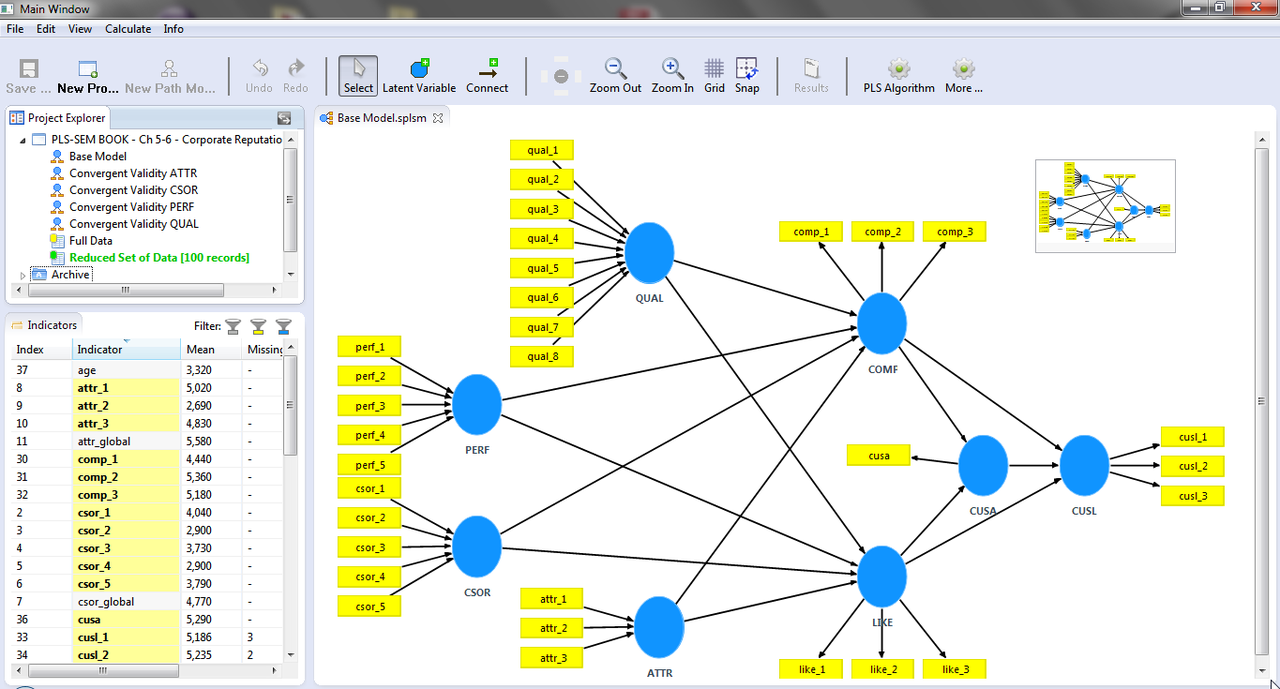
Partial least squares structural equation modeling (PLS-SEM) enables researchers to model and estimate complex cause-effects relationship models
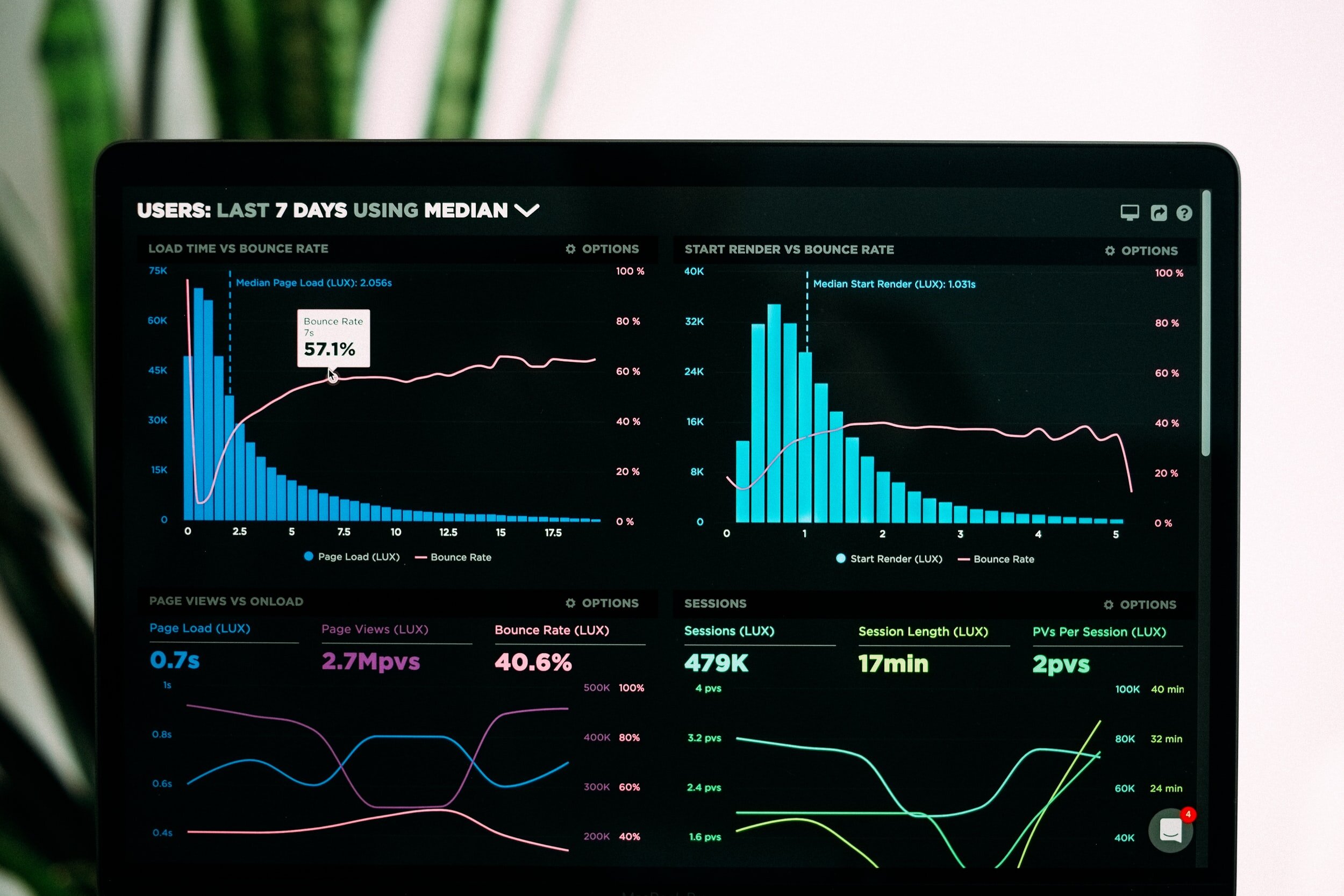
Find tips to help you share your research and numerical findings.

Dr. Stephen Gorard defines and explains randomness in a research context.

Mentor in Residence Stephen Gorard explains how researchers can think about predicting results.
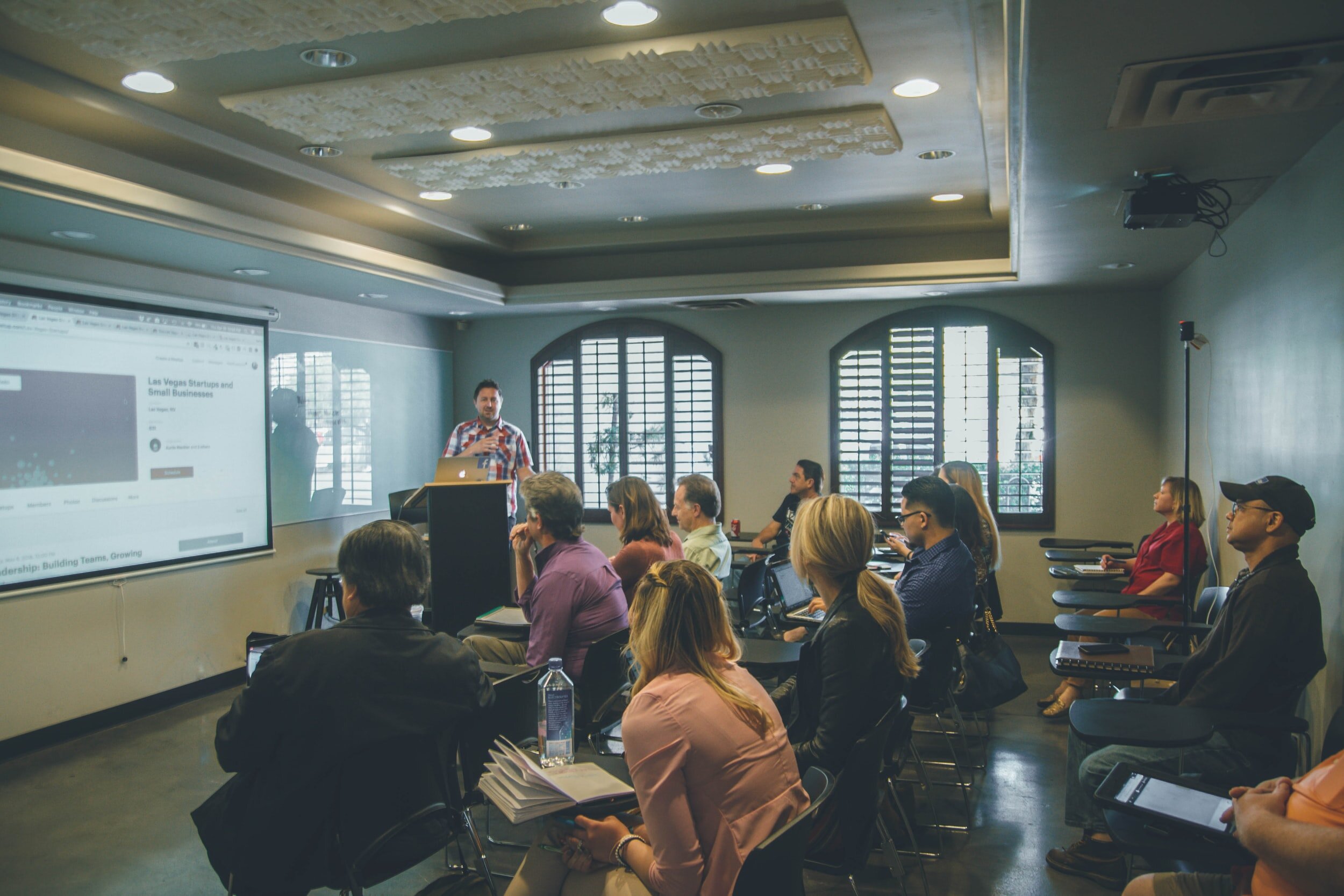
Instructional tips for teaching quantitative data analysis.

Images contain information absent in text, and this extra information presents opportunities and challenges. It is an opportunity because one image can document variables with which text sources (newspaper articles, speeches or legislative documents) struggle or on datasets too large to feasibly code manually. Learn how to overcome the challenges.

Tips for dealing with missing data from Dr. Stephen Gorard, author of How to Make Sense of Statistics.
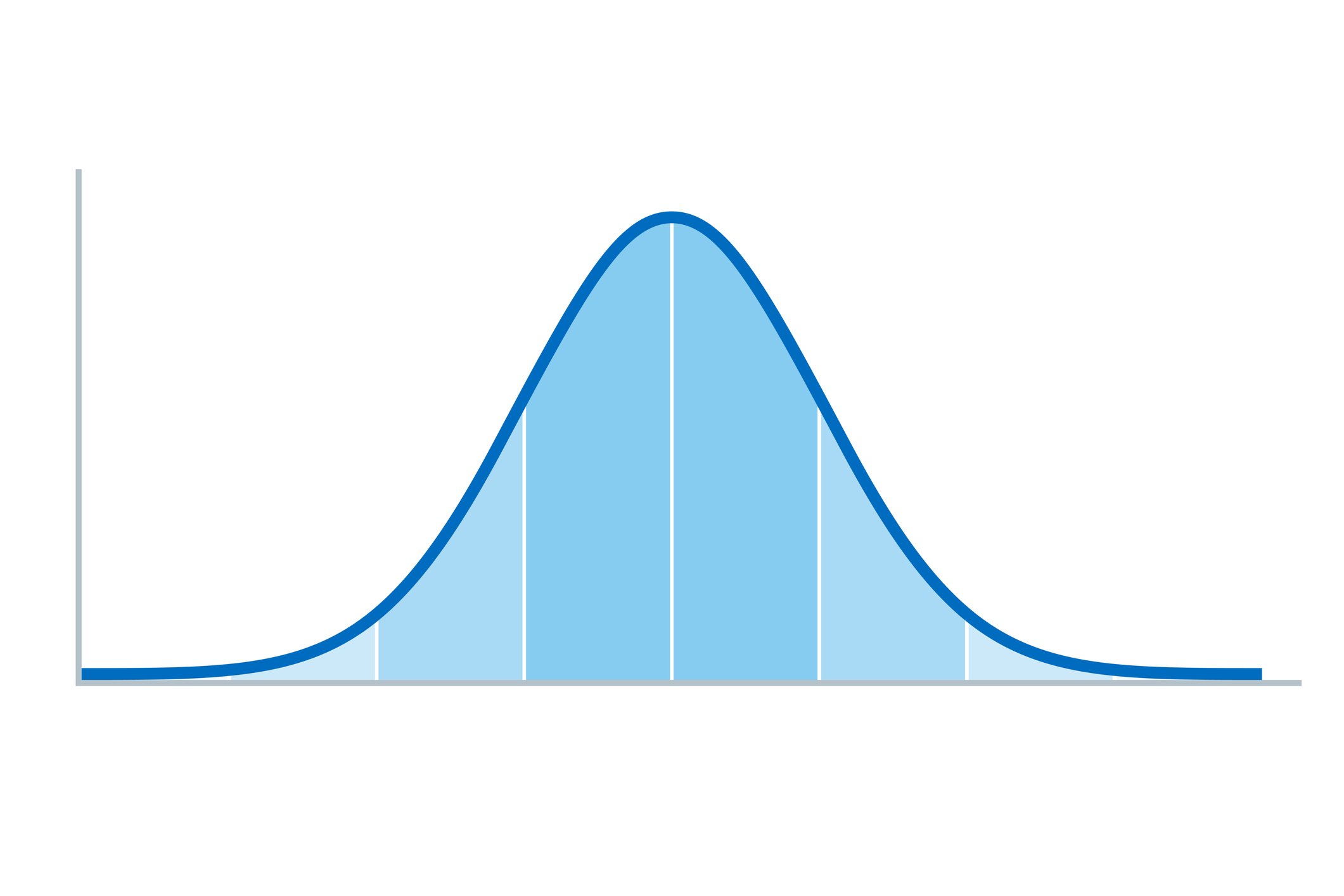
Learn more about standard deviation from a paper and presentation from Dr. Stephen Gorard.

How can you use Excel in your data analysis? Charlotte Brookfield explains!

Have you seen Dr. Gorard use card tricks to teach research methods? Watch this video!

Don’t have funds for data analysis software? Use Excel! Learn how in this interview with Charlotte Brookfield.

Listen to Dr. Stephen Gorard discuss his no-nonsense approach to statistics.

Professor Julie Scott Jones discusses lessons learned from teaching quantitative research methods online.

After 20 years of teaching research and quantitative methods to students in Political Science in the US, UK, and the EU, Dr. Loveless has developed a teaching method that has resulted in greater student success in statistics in each passing year

Mentor in Residence Stephen Gorard explains how to use population data.

Dr. Ann Sloan Devlin, author of The Research Experience, discusses first steps in data analysis for quantitative studies.

Want to use R for statistical analysis? These open-access resources might help!

Learn about R and find books about using this language and environment for statistical computing and graphics.

Learn about research with online Experiments from Dr. Giuseppe Veltri.

What is the difference between experimental and non-experimental research design? We look at how non-experimental design distinguishes itself from experimental design and how it can be applied in the research process with open-access examples.

Download the free report from the project, “Fostering Data Literacy: Teaching with Quantitative Data in the Social Sciences.” This report explores two key challenges to teaching with data: helping students overcome anxieties about math and synchronizing the interconnected methodological, software, and analytic competencies.

In the day-to-day of political communication, politicians constantly decide how to amplify or constrain emotional expression, in service of signalling policy priorities or persuading colleagues and voters. We propose a new method for quantifying emotionality in politics using the transcribed text of politicians’ speeches. This new approach, described in more detail below, uses computational linguistics tools and can be validated against human judgments of emotionality.

Institutions — rules that govern behavior — are among the most important social artifacts of society. So it should come as a great shock that we still understand them so poorly. How are institutions designed? What makes institutions work? Is there a way to systematically compare the language of different institutions? One recent advance is bringing us closer to making these questions quantitatively approachable. The Institutional Grammar (IG) 2.0 is an analytical approach, drawn directly from classic work by Nobel Laureate Elinor Ostrom, that is providing the foundation for computational representations of institutions. IG 2.0 is a formalism for translating between human-language outputs — policies, rules, laws, decisions, and the like. It defines abstract structures precisely enough to be manipulable by computer. Recent work, supported by the National Science Foundation ( RCN: Coordinating and Advancing Analytical Approaches for Policy Design & GCR: Collaborative Research: Jumpstarting Successful Open-Source Software Projects With Evidence-Based Rules and Structures ), leveraging recent advances in natural language processing highlighted on this blog , is vastly accelerating the rate and quality of computational translations of written rules.

What is case study methodology? It is unique given one characteristic: case studies draw from more than one data source. In this post find definitions and a collection of multidisciplinary examples.

Learn about experimental research designs and read open-access studies.

In the field of artificial intelligence (AI), Transformers have revolutionized language analysis. Never before has a new technology universally improved the benchmarks of nearly all language processing tasks: e.g., general language understanding, question - answering , and Web search . The transformer method itself, which probabilistically models words in their context (i.e. “language modeling”), was introduced in 2017 and the first large-scale pre-trained general purpose transformer, BERT, was released open source from Google in 2018. Since then, BERT has been followed by a wave of new transformer models including GPT, RoBERTa, DistilBERT, XLNet, Transformer-XL, CamemBERT, XLM-RoBERTa, etc. The text package makes all of these language models and many more easily accessible to use for R-users; and includes functions optimized for human-level analyses tailored to social scientists.

This year’s lockdown challenged the absolute core of higher education and accelerated or rather imposed the adoption of digital tooling to fully replace the interactivity of the physical classroom. And while other industries might have suffered losses, the edtech space flourished, with funding for edtech almost doubling in the first half of 2020 vs 2019 . Even before the pandemic, lecturers were starting to feel overwhelmed by the amount of choice to support their teaching. More funding just meant more hype, more tools, and more tools working on similar or slightly improved solutions, making it even harder and more time-consuming to find and adapt them in a rush.
Below, we take a look at several tools and startups that are already supporting many of you in teaching quantitative research methods; and some cool new tools you could use to enhance your classroom.
Pros and Cons of Online Survey Research
Research with black participants: scholars rethink methods and methodology.

Up to 65% off on all yearly plans! 🎁 Start fresh with a yearly plan. Now 65% off! ❄️ 🏷️
- Form Builder
- Survey Maker
- AI Form Generator
- AI Survey Tool
- AI Quiz Maker
- Store Builder
- WordPress Plugin
HubSpot CRM
Google Sheets
Google Analytics
Microsoft Excel
- Popular Forms
- Job Application Form Template
- Rental Application Form Template
- Hotel Accommodation Form Template
- Online Registration Form Template
- Employment Application Form Template
- Application Forms
- Booking Forms
- Consent Forms
- Contact Forms
- Donation Forms
- Customer Satisfaction Surveys
- Employee Satisfaction Surveys
- Evaluation Surveys
- Feedback Surveys
- Market Research Surveys
- Personality Quiz Template
- Geography Quiz Template
- Math Quiz Template
- Science Quiz Template
- Vocabulary Quiz Template
Try without registration Quick Start
Read engaging stories, how-to guides, learn about forms.app features.
Inspirational ready-to-use templates for getting started fast and powerful.
Spot-on guides on how to use forms.app and make the most out of it.
See the technical measures we take and learn how we keep your data safe and secure.
- Integrations
- Help Center
- Sign In Sign Up Free
- What is non-experimental research: Definition, types & examples
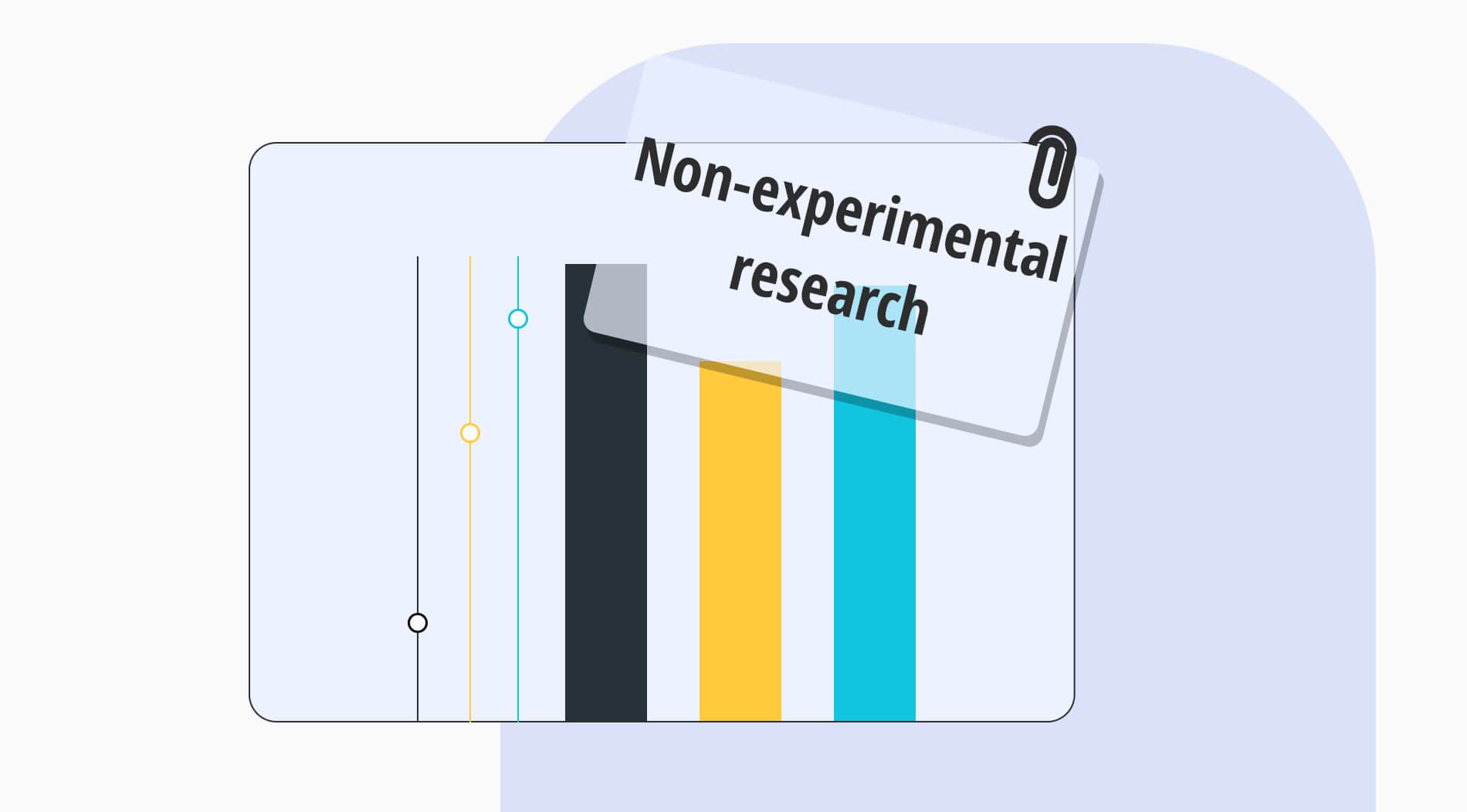
Defne Çobanoğlu
The experimentation method is very useful for getting information on a specific subject. However, when experimenting is not possible or practical, there is another way of collecting data for those interested. It's a non-experimental way, to say the least.
In this article, we have gathered information on non-experimental research, clearly defined what it is and when one should use it, and listed the types of non-experimental research. We also gave some useful examples to paint a better picture. Let us get started.
- What is non-experimental research?
Non-experimental research is a type of research design that is based on observation and measuring instead of experimentation with randomly assigned participants.
What characterizes this research design is the fact that it lacks the manipulation of independent variables . Because of this fact, the non-experimental research is based on naturally occurring conditions, and there is no involvement of external interventions. Therefore, the researchers doing this method must not rely heavily on interviews, surveys , or case studies.
- When to use non-experimental research?
An experiment is done when a researcher is investigating the relationship between one or two phenomena and has a theory or hypothesis on the relationship between two variables that are involved. The researcher can carry out an experiment when it is ethical, possible, and feasible to do one.
However, when an experiment can not be done because of a limitation, then they decide to opt for a non-experimental research design . Non-experimental research is considered preferable in some conditions, including:
- When the manipulation of the independent variable is not possible because of ethical or practical concerns
- When the subjects of an experimental design can not be randomly assigned to treatments.
- When the research question is too extensive or it relates to a general experience.
- When researchers want to do a starter research before investing in more extensive research.
- When the research question is about the statistical relationship between variables , but in a noncausal context.
- Characteristics of non-experimental research
Non-experimental research has some characteristics that clearly define the framework of this research method. They provide a clear distinction between experimental design and non-experimental design. Let us see some of them:
- Non-experimental research does not involve the manipulation of variables .
- The aim of this research type is to explore the factors as they naturally occur .
- This method is used when experimentation is not possible because of ethical or practical reasons .
- Instead of creating a sample or participant group, the existing groups or natural thresholds are used during the research.
- This research method is not about finding causality between two variables.
- Most studies are done on past events or historical occurrences to make sense of specific research questions.
- Types of non-experimental research
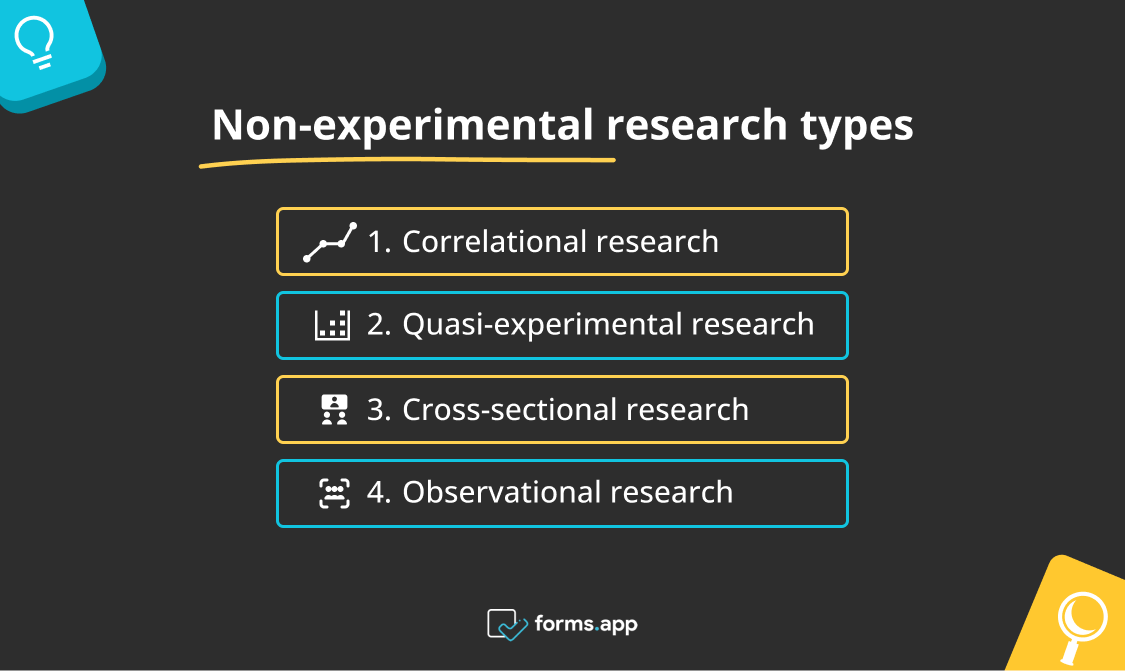
Non-experimental research types
What makes research non-experimental research is the fact that the researcher does not manipulate the factors, does not randomly assign the participants, and observes the existing groups. But this research method can also be divided into different types. These types are:
Correlational research:
In correlation studies, the researcher does not manipulate the variables and is not interested in controlling the extraneous variables. They only observe and assess the relationship between them. For example, a researcher examines students’ study hours every day and their overall academic performance. The positive correlation this between study hours and academic performance suggests a statistical association.
Quasi-experimental research:
In quasi-experimental research, the researcher does not randomly assign the participants into two groups. Because you can not deliberately deprive someone of treatment, the researcher uses natural thresholds or dividing points . For example, examining students from two different high schools with different education methods.
Cross-sectional research:
In cross-sectional research, the researcher studies and compares a portion of a population at the same time . It does not involve random assignment or any outside manipulation. For example, a study on smokers and non-smokers in a specific area.
Observational research:
In observational research, the researcher once again does not manipulate any aspect of the study, and their main focus is observation of the participants . For example, a researcher examining a group of children playing in a playground would be a good example.
- Non-experimental research examples
Non-experimental research is a good way of collecting information and exploring relationships between variables. It can be used in numerous fields, from social sciences, economics, psychology, education, and market research. When gathering information using secondary research is not enough and an experiment can not be done, this method can bring out new information.
Non-experimental research example #1
Imagine a researcher who wants to see the connection between mobile phone usage before bedtime and the amount of sleep adults get in a night . They can gather a group of individuals to observe and present them with some questions asking about the details of their day, frequency and duration of phone usage, quality of sleep, etc . And observe them by analyzing the findings.
Non-experimental research example #2
Imagine a researcher who wants to explore the correlation between job satisfaction levels among employees and what are the factors that affect this . The researcher can gather all the information they get about the employees’ ages, sexes, positions in the company, working patterns, demographic information, etc .
The research provides the researcher with all the information to make an analysis to identify correlations and patterns. Then, it is possible for researchers and administrators to make informed predictions.
- Frequently asked questions about non-experimental research
When not to use non-experimental research?
There are some situations where non-experimental research is not suitable or the best choice. For example, the aim of non-experimental research is not about finding causality therefore, if the researcher wants to explore the relationship between two variables, then this method is not for them. Also, if the control over the variables is extremely important to the test of a theory, then experimentation is a more appropriate option.
What is the difference between experimental and non-experimental research?
Experimental research is an example of primary research where the researcher takes control of all the variables, randomly assigns the participants into different groups, and studies them in a pre-determined environment to test a hypothesis.
On the contrary, non-experimental research does not intervene in any way and only observes and studies the participants in their natural environments to make sense of a phenomenon
What makes a quasi-experiment a non-experiment?
The same as true experimentation, quasi-experiment research also aims to explore a cause-and-effect relationship between independent and dependent variables. However, in quasi-experimental research, the participants are not randomly selected. They are assigned to groups based on non-random criteria .
Is a survey a non-experimental study?
Yes, as the main purpose of a survey or questionnaire is to collect information from participants without outside interference, it makes the survey a non-experimental study. Surveys are used by researchers when experimentation is not possible because of ethical reasons, but first-hand data is needed
What is non-experimental data?
Non-experimental data is data collected by researchers via using non-experimental methods such as observations, interpretation, and interactions. Non-experimental data could both be qualitative or quantitative, depending on the situation.
Advantages of non-experimental research
Non-experimental research has its positive sides that a researcher should have in mind when going through a study. They can start their research by going through the advantages. These advantages are:
- It is used to observe and analyze past events .
- This method is more affordable than a true experiment .
- As the researcher can adapt the methods during the study, this research type is more flexible than an experimental study.
- This method allows the researchers to answer specific questions .
Disadvantages of non-experimental research
Even though non-experimental research has its advantages, it also has some disadvantages a researcher should be mindful of. Here are some of them:
- The findings of non-experimental research can not be generalized to the whole population. Therefore, it has low external validity .
- This research is used to explore only a single variable .
- Non-experimental research designs are prone to researcher bias and may not produce neutral results.
- Final words
A non-experimental study differs from an experimental study in that there is no intervention or change of internal or extraneous elements. It is a smart way to collect information without the limitations of experimentation. These limitations could be about ethical or practical problems. When you can not do proper experimentation, your other option is to study existing conditions and groups to draw conclusions. This is a non-experimental design .
In this article, we have gathered information on non-experimental research to shed light on the details of this research method. If you are thinking of doing a study, make sure to have this information in mind. And lastly, do not forget to visit our articles on other research methods and so much more!
Defne is a content writer at forms.app. She is also a translator specializing in literary translation. Defne loves reading, writing, and translating professionally and as a hobby. Her expertise lies in survey research, research methodologies, content writing, and translation.
- Form Features
- Data Collection

Table of Contents
Related posts.
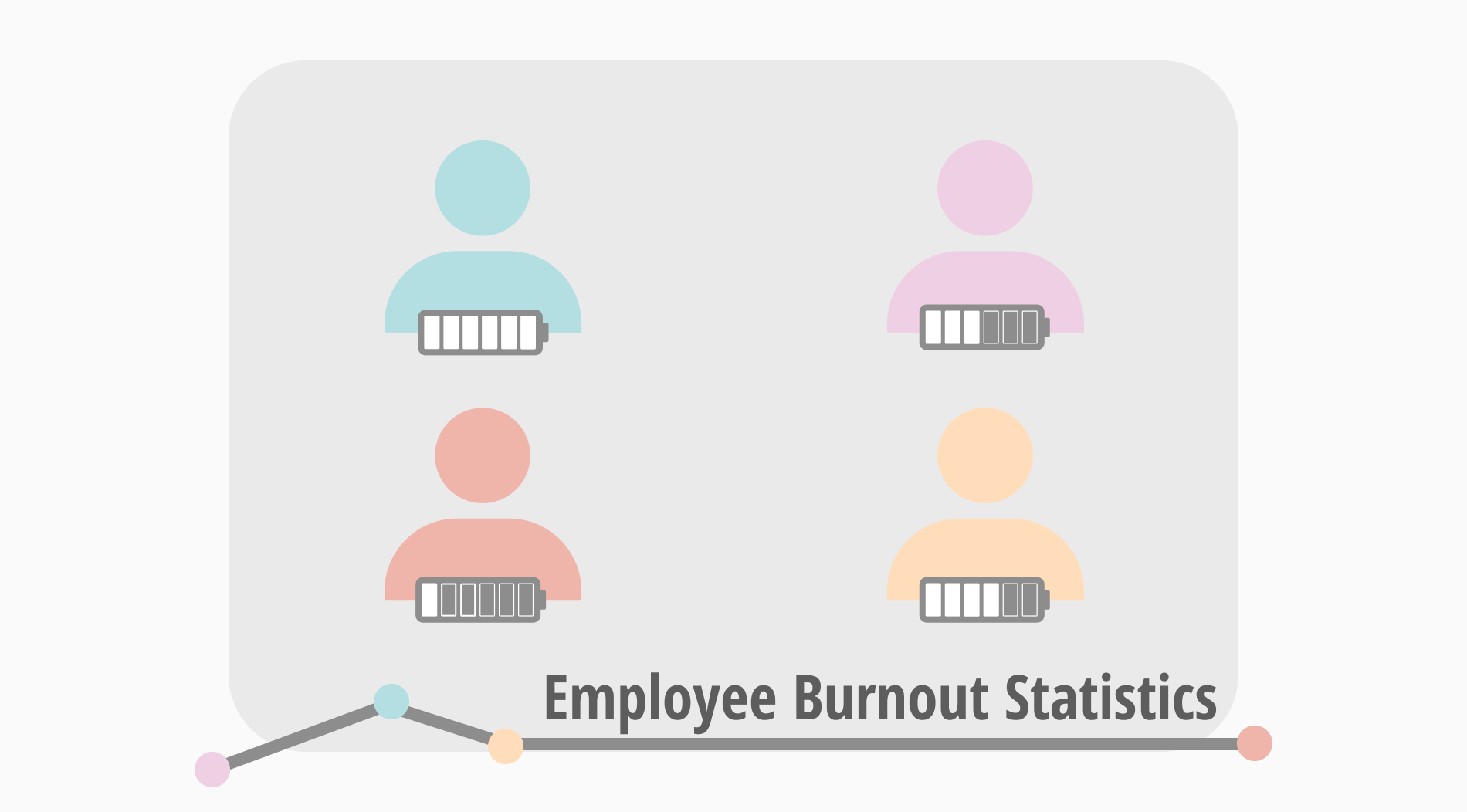
20+ Employee burnout statistics that will shock you
Fatih Özkan

Patient booking forms: Definition, questions and how to create
Yulia Guseva
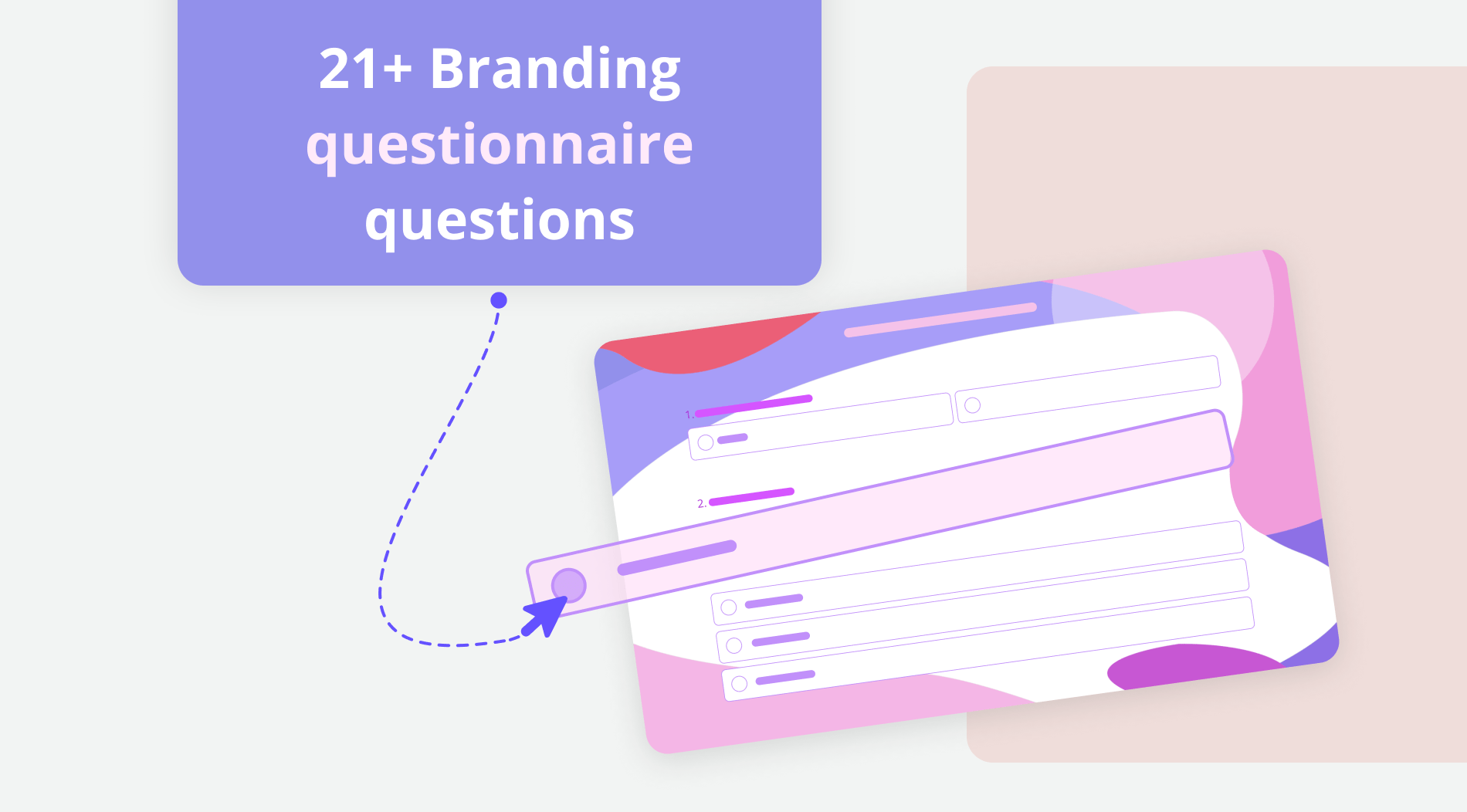
21+ Branding questionnaire questions to understand your clients
Ayşegül Nacu

Want to create or adapt books like this? Learn more about how Pressbooks supports open publishing practices.
Chapter 7: Nonexperimental Research
Overview of Nonexperimental Research
Learning Objectives
- Define nonexperimental research, distinguish it clearly from experimental research, and give several examples.
- Explain when a researcher might choose to conduct nonexperimental research as opposed to experimental research.
What Is Nonexperimental Research?
Nonexperimental research is research that lacks the manipulation of an independent variable, random assignment of participants to conditions or orders of conditions, or both.
In a sense, it is unfair to define this large and diverse set of approaches collectively by what they are not . But doing so reflects the fact that most researchers in psychology consider the distinction between experimental and nonexperimental research to be an extremely important one. This distinction is because although experimental research can provide strong evidence that changes in an independent variable cause differences in a dependent variable, nonexperimental research generally cannot. As we will see, however, this inability does not mean that nonexperimental research is less important than experimental research or inferior to it in any general sense.
When to Use Nonexperimental Research
As we saw in Chapter 6 , experimental research is appropriate when the researcher has a specific research question or hypothesis about a causal relationship between two variables—and it is possible, feasible, and ethical to manipulate the independent variable and randomly assign participants to conditions or to orders of conditions. It stands to reason, therefore, that nonexperimental research is appropriate—even necessary—when these conditions are not met. There are many ways in which preferring nonexperimental research can be the case.
- The research question or hypothesis can be about a single variable rather than a statistical relationship between two variables (e.g., How accurate are people’s first impressions?).
- The research question can be about a noncausal statistical relationship between variables (e.g., Is there a correlation between verbal intelligence and mathematical intelligence?).
- The research question can be about a causal relationship, but the independent variable cannot be manipulated or participants cannot be randomly assigned to conditions or orders of conditions (e.g., Does damage to a person’s hippocampus impair the formation of long-term memory traces?).
- The research question can be broad and exploratory, or it can be about what it is like to have a particular experience (e.g., What is it like to be a working mother diagnosed with depression?).
Again, the choice between the experimental and nonexperimental approaches is generally dictated by the nature of the research question. If it is about a causal relationship and involves an independent variable that can be manipulated, the experimental approach is typically preferred. Otherwise, the nonexperimental approach is preferred. But the two approaches can also be used to address the same research question in complementary ways. For example, nonexperimental studies establishing that there is a relationship between watching violent television and aggressive behaviour have been complemented by experimental studies confirming that the relationship is a causal one (Bushman & Huesmann, 2001) [1] . Similarly, after his original study, Milgram conducted experiments to explore the factors that affect obedience. He manipulated several independent variables, such as the distance between the experimenter and the participant, the participant and the confederate, and the location of the study (Milgram, 1974) [2] .
Types of Nonexperimental Research
Nonexperimental research falls into three broad categories: single-variable research, correlational and quasi-experimental research, and qualitative research. First, research can be nonexperimental because it focuses on a single variable rather than a statistical relationship between two variables. Although there is no widely shared term for this kind of research, we will call it single-variable research . Milgram’s original obedience study was nonexperimental in this way. He was primarily interested in one variable—the extent to which participants obeyed the researcher when he told them to shock the confederate—and he observed all participants performing the same task under the same conditions. The study by Loftus and Pickrell described at the beginning of this chapter is also a good example of single-variable research. The variable was whether participants “remembered” having experienced mildly traumatic childhood events (e.g., getting lost in a shopping mall) that they had not actually experienced but that the research asked them about repeatedly. In this particular study, nearly a third of the participants “remembered” at least one event. (As with Milgram’s original study, this study inspired several later experiments on the factors that affect false memories.)
As these examples make clear, single-variable research can answer interesting and important questions. What it cannot do, however, is answer questions about statistical relationships between variables. This detail is a point that beginning researchers sometimes miss. Imagine, for example, a group of research methods students interested in the relationship between children’s being the victim of bullying and the children’s self-esteem. The first thing that is likely to occur to these researchers is to obtain a sample of middle-school students who have been bullied and then to measure their self-esteem. But this design would be a single-variable study with self-esteem as the only variable. Although it would tell the researchers something about the self-esteem of children who have been bullied, it would not tell them what they really want to know, which is how the self-esteem of children who have been bullied compares with the self-esteem of children who have not. Is it lower? Is it the same? Could it even be higher? To answer this question, their sample would also have to include middle-school students who have not been bullied thereby introducing another variable.
Research can also be nonexperimental because it focuses on a statistical relationship between two variables but does not include the manipulation of an independent variable, random assignment of participants to conditions or orders of conditions, or both. This kind of research takes two basic forms: correlational research and quasi-experimental research. In correlational research , the researcher measures the two variables of interest with little or no attempt to control extraneous variables and then assesses the relationship between them. A research methods student who finds out whether each of several middle-school students has been bullied and then measures each student’s self-esteem is conducting correlational research. In quasi-experimental research , the researcher manipulates an independent variable but does not randomly assign participants to conditions or orders of conditions. For example, a researcher might start an antibullying program (a kind of treatment) at one school and compare the incidence of bullying at that school with the incidence at a similar school that has no antibullying program.
The final way in which research can be nonexperimental is that it can be qualitative. The types of research we have discussed so far are all quantitative, referring to the fact that the data consist of numbers that are analyzed using statistical techniques. In qualitative research , the data are usually nonnumerical and therefore cannot be analyzed using statistical techniques. Rosenhan’s study of the experience of people in a psychiatric ward was primarily qualitative. The data were the notes taken by the “pseudopatients”—the people pretending to have heard voices—along with their hospital records. Rosenhan’s analysis consists mainly of a written description of the experiences of the pseudopatients, supported by several concrete examples. To illustrate the hospital staff’s tendency to “depersonalize” their patients, he noted, “Upon being admitted, I and other pseudopatients took the initial physical examinations in a semipublic room, where staff members went about their own business as if we were not there” (Rosenhan, 1973, p. 256). [3] Qualitative data has a separate set of analysis tools depending on the research question. For example, thematic analysis would focus on themes that emerge in the data or conversation analysis would focus on the way the words were said in an interview or focus group.
Internal Validity Revisited
Recall that internal validity is the extent to which the design of a study supports the conclusion that changes in the independent variable caused any observed differences in the dependent variable. Figure 7.1 shows how experimental, quasi-experimental, and correlational research vary in terms of internal validity. Experimental research tends to be highest because it addresses the directionality and third-variable problems through manipulation and the control of extraneous variables through random assignment. If the average score on the dependent variable in an experiment differs across conditions, it is quite likely that the independent variable is responsible for that difference. Correlational research is lowest because it fails to address either problem. If the average score on the dependent variable differs across levels of the independent variable, it could be that the independent variable is responsible, but there are other interpretations. In some situations, the direction of causality could be reversed. In others, there could be a third variable that is causing differences in both the independent and dependent variables. Quasi-experimental research is in the middle because the manipulation of the independent variable addresses some problems, but the lack of random assignment and experimental control fails to address others. Imagine, for example, that a researcher finds two similar schools, starts an antibullying program in one, and then finds fewer bullying incidents in that “treatment school” than in the “control school.” There is no directionality problem because clearly the number of bullying incidents did not determine which school got the program. However, the lack of random assignment of children to schools could still mean that students in the treatment school differed from students in the control school in some other way that could explain the difference in bullying.

Notice also in Figure 7.1 that there is some overlap in the internal validity of experiments, quasi-experiments, and correlational studies. For example, a poorly designed experiment that includes many confounding variables can be lower in internal validity than a well designed quasi-experiment with no obvious confounding variables. Internal validity is also only one of several validities that one might consider, as noted in Chapter 5.
Key Takeaways
- Nonexperimental research is research that lacks the manipulation of an independent variable, control of extraneous variables through random assignment, or both.
- There are three broad types of nonexperimental research. Single-variable research focuses on a single variable rather than a relationship between variables. Correlational and quasi-experimental research focus on a statistical relationship but lack manipulation or random assignment. Qualitative research focuses on broader research questions, typically involves collecting large amounts of data from a small number of participants, and analyses the data nonstatistically.
- In general, experimental research is high in internal validity, correlational research is low in internal validity, and quasi-experimental research is in between.
Discussion: For each of the following studies, decide which type of research design it is and explain why.
- A researcher conducts detailed interviews with unmarried teenage fathers to learn about how they feel and what they think about their role as fathers and summarizes their feelings in a written narrative.
- A researcher measures the impulsivity of a large sample of drivers and looks at the statistical relationship between this variable and the number of traffic tickets the drivers have received.
- A researcher randomly assigns patients with low back pain either to a treatment involving hypnosis or to a treatment involving exercise. She then measures their level of low back pain after 3 months.
- A college instructor gives weekly quizzes to students in one section of his course but no weekly quizzes to students in another section to see whether this has an effect on their test performance.
- Bushman, B. J., & Huesmann, L. R. (2001). Effects of televised violence on aggression. In D. Singer & J. Singer (Eds.), Handbook of children and the media (pp. 223–254). Thousand Oaks, CA: Sage. ↵
- Milgram, S. (1974). Obedience to authority: An experimental view . New York, NY: Harper & Row. ↵
- Rosenhan, D. L. (1973). On being sane in insane places. Science, 179 , 250–258. ↵
Research that lacks the manipulation of an independent variable, random assignment of participants to conditions or orders of conditions, or both.
Research that focuses on a single variable rather than a statistical relationship between two variables.
The researcher measures the two variables of interest with little or no attempt to control extraneous variables and then assesses the relationship between them.
The researcher manipulates an independent variable but does not randomly assign participants to conditions or orders of conditions.
Research Methods in Psychology - 2nd Canadian Edition Copyright © 2015 by Paul C. Price, Rajiv Jhangiani, & I-Chant A. Chiang is licensed under a Creative Commons Attribution-NonCommercial-ShareAlike 4.0 International License , except where otherwise noted.
Share This Book

Want to create or adapt books like this? Learn more about how Pressbooks supports open publishing practices.
7.1 Overview of Nonexperimental Research
Learning objectives.
- Define nonexperimental research, distinguish it clearly from experimental research, and give several examples.
- Explain when a researcher might choose to conduct nonexperimental research as opposed to experimental research.
What Is Nonexperimental Research?
Nonexperimental research is research that lacks the manipulation of an independent variable, random assignment of participants to conditions or orders of conditions, or both.
In a sense, it is unfair to define this large and diverse set of approaches collectively by what they are not . But doing so reflects the fact that most researchers in psychology consider the distinction between experimental and nonexperimental research to be an extremely important one. This is because while experimental research can provide strong evidence that changes in an independent variable cause differences in a dependent variable, nonexperimental research generally cannot. As we will see, however, this does not mean that nonexperimental research is less important than experimental research or inferior to it in any general sense.
When to Use Nonexperimental Research
As we saw in Chapter 6 “Experimental Research” , experimental research is appropriate when the researcher has a specific research question or hypothesis about a causal relationship between two variables—and it is possible, feasible, and ethical to manipulate the independent variable and randomly assign participants to conditions or to orders of conditions. It stands to reason, therefore, that nonexperimental research is appropriate—even necessary—when these conditions are not met. There are many ways in which this can be the case.
- The research question or hypothesis can be about a single variable rather than a statistical relationship between two variables (e.g., How accurate are people’s first impressions?).
- The research question can be about a noncausal statistical relationship between variables (e.g., Is there a correlation between verbal intelligence and mathematical intelligence?).
- The research question can be about a causal relationship, but the independent variable cannot be manipulated or participants cannot be randomly assigned to conditions or orders of conditions (e.g., Does damage to a person’s hippocampus impair the formation of long-term memory traces?).
- The research question can be broad and exploratory, or it can be about what it is like to have a particular experience (e.g., What is it like to be a working mother diagnosed with depression?).
Again, the choice between the experimental and nonexperimental approaches is generally dictated by the nature of the research question. If it is about a causal relationship and involves an independent variable that can be manipulated, the experimental approach is typically preferred. Otherwise, the nonexperimental approach is preferred. But the two approaches can also be used to address the same research question in complementary ways. For example, nonexperimental studies establishing that there is a relationship between watching violent television and aggressive behavior have been complemented by experimental studies confirming that the relationship is a causal one (Bushman & Huesmann, 2001). Similarly, after his original study, Milgram conducted experiments to explore the factors that affect obedience. He manipulated several independent variables, such as the distance between the experimenter and the participant, the participant and the confederate, and the location of the study (Milgram, 1974).
Types of Nonexperimental Research
Nonexperimental research falls into three broad categories: single-variable research, correlational and quasi-experimental research, and qualitative research. First, research can be nonexperimental because it focuses on a single variable rather than a statistical relationship between two variables. Although there is no widely shared term for this kind of research, we will call it single-variable research . Milgram’s original obedience study was nonexperimental in this way. He was primarily interested in one variable—the extent to which participants obeyed the researcher when he told them to shock the confederate—and he observed all participants performing the same task under the same conditions. The study by Loftus and Pickrell described at the beginning of this chapter is also a good example of single-variable research. The variable was whether participants “remembered” having experienced mildly traumatic childhood events (e.g., getting lost in a shopping mall) that they had not actually experienced but that the research asked them about repeatedly. In this particular study, nearly a third of the participants “remembered” at least one event. (As with Milgram’s original study, this study inspired several later experiments on the factors that affect false memories.)
As these examples make clear, single-variable research can answer interesting and important questions. What it cannot do, however, is answer questions about statistical relationships between variables. This is a point that beginning researchers sometimes miss. Imagine, for example, a group of research methods students interested in the relationship between children’s being the victim of bullying and the children’s self-esteem. The first thing that is likely to occur to these researchers is to obtain a sample of middle-school students who have been bullied and then to measure their self-esteem. But this would be a single-variable study with self-esteem as the only variable. Although it would tell the researchers something about the self-esteem of children who have been bullied, it would not tell them what they really want to know, which is how the self-esteem of children who have been bullied compares with the self-esteem of children who have not. Is it lower? Is it the same? Could it even be higher? To answer this question, their sample would also have to include middle-school students who have not been bullied.
Research can also be nonexperimental because it focuses on a statistical relationship between two variables but does not include the manipulation of an independent variable, random assignment of participants to conditions or orders of conditions, or both. This kind of research takes two basic forms: correlational research and quasi-experimental research. In correlational research , the researcher measures the two variables of interest with little or no attempt to control extraneous variables and then assesses the relationship between them. A research methods student who finds out whether each of several middle-school students has been bullied and then measures each student’s self-esteem is conducting correlational research. In quasi-experimental research , the researcher manipulates an independent variable but does not randomly assign participants to conditions or orders of conditions. For example, a researcher might start an antibullying program (a kind of treatment) at one school and compare the incidence of bullying at that school with the incidence at a similar school that has no antibullying program.
The final way in which research can be nonexperimental is that it can be qualitative. The types of research we have discussed so far are all quantitative, referring to the fact that the data consist of numbers that are analyzed using statistical techniques. In qualitative research , the data are usually nonnumerical and are analyzed using nonstatistical techniques. Rosenhan’s study of the experience of people in a psychiatric ward was primarily qualitative. The data were the notes taken by the “pseudopatients”—the people pretending to have heard voices—along with their hospital records. Rosenhan’s analysis consists mainly of a written description of the experiences of the pseudopatients, supported by several concrete examples. To illustrate the hospital staff’s tendency to “depersonalize” their patients, he noted, “Upon being admitted, I and other pseudopatients took the initial physical examinations in a semipublic room, where staff members went about their own business as if we were not there” (Rosenhan, 1973, p. 256).
Internal Validity Revisited
Recall that internal validity is the extent to which the design of a study supports the conclusion that changes in the independent variable caused any observed differences in the dependent variable. Figure 7.1 shows how experimental, quasi-experimental, and correlational research vary in terms of internal validity. Experimental research tends to be highest because it addresses the directionality and third-variable problems through manipulation and the control of extraneous variables through random assignment. If the average score on the dependent variable in an experiment differs across conditions, it is quite likely that the independent variable is responsible for that difference. Correlational research is lowest because it fails to address either problem. If the average score on the dependent variable differs across levels of the independent variable, it could be that the independent variable is responsible, but there are other interpretations. In some situations, the direction of causality could be reversed. In others, there could be a third variable that is causing differences in both the independent and dependent variables. Quasi-experimental research is in the middle because the manipulation of the independent variable addresses some problems, but the lack of random assignment and experimental control fails to address others. Imagine, for example, that a researcher finds two similar schools, starts an antibullying program in one, and then finds fewer bullying incidents in that “treatment school” than in the “control school.” There is no directionality problem because clearly the number of bullying incidents did not determine which school got the program. However, the lack of random assignment of children to schools could still mean that students in the treatment school differed from students in the control school in some other way that could explain the difference in bullying.

Experiments are generally high in internal validity, quasi-experiments lower, and correlational studies lower still.
Notice also in Figure 7.1 that there is some overlap in the internal validity of experiments, quasi-experiments, and correlational studies. For example, a poorly designed experiment that includes many confounding variables can be lower in internal validity than a well designed quasi-experiment with no obvious confounding variables.
Key Takeaways
- Nonexperimental research is research that lacks the manipulation of an independent variable, control of extraneous variables through random assignment, or both.
- There are three broad types of nonexperimental research. Single-variable research focuses on a single variable rather than a relationship between variables. Correlational and quasi-experimental research focus on a statistical relationship but lack manipulation or random assignment. Qualitative research focuses on broader research questions, typically involves collecting large amounts of data from a small number of participants, and analyzes the data nonstatistically.
- In general, experimental research is high in internal validity, correlational research is low in internal validity, and quasi-experimental research is in between.
Discussion: For each of the following studies, decide which type of research design it is and explain why.
- A researcher conducts detailed interviews with unmarried teenage fathers to learn about how they feel and what they think about their role as fathers and summarizes their feelings in a written narrative.
- A researcher measures the impulsivity of a large sample of drivers and looks at the statistical relationship between this variable and the number of traffic tickets the drivers have received.
- A researcher randomly assigns patients with low back pain either to a treatment involving hypnosis or to a treatment involving exercise. She then measures their level of low back pain after 3 months.
- A college instructor gives weekly quizzes to students in one section of his course but no weekly quizzes to students in another section to see whether this has an effect on their test performance.
Bushman, B. J., & Huesmann, L. R. (2001). Effects of televised violence on aggression. In D. Singer & J. Singer (Eds.), Handbook of children and the media (pp. 223–254). Thousand Oaks, CA: Sage.
Milgram, S. (1974). Obedience to authority: An experimental view . New York, NY: Harper & Row.
Rosenhan, D. L. (1973). On being sane in insane places. Science, 179 , 250–258.
Research Methods in Psychology Copyright © 2016 by University of Minnesota is licensed under a Creative Commons Attribution-NonCommercial-ShareAlike 4.0 International License , except where otherwise noted.

Want to create or adapt books like this? Learn more about how Pressbooks supports open publishing practices.
Overview of Non-Experimental Research
Rajiv S. Jhangiani; I-Chant A. Chiang; Carrie Cuttler; and Dana C. Leighton
Learning Objectives
- Define non-experimental research, distinguish it clearly from experimental research, and give several examples.
- Explain when a researcher might choose to conduct non-experimental research as opposed to experimental research.
What Is Non-Experimental Research?
Non-experimental research is research that lacks the manipulation of an independent variable. Rather than manipulating an independent variable, researchers conducting non-experimental research simply measure variables as they naturally occur (in the lab or real world).
Most researchers in psychology consider the distinction between experimental and non-experimental research to be an extremely important one. This is because although experimental research can provide strong evidence that changes in an independent variable cause differences in a dependent variable, non-experimental research generally cannot. As we will see, however, this inability to make causal conclusions does not mean that non-experimental research is less important than experimental research. It is simply used in cases where experimental research is not able to be carried out.
When to Use Non-Experimental Research
As we saw in the last chapter , experimental research is appropriate when the researcher has a specific research question or hypothesis about a causal relationship between two variables—and it is possible, feasible, and ethical to manipulate the independent variable. It stands to reason, therefore, that non-experimental research is appropriate—even necessary—when these conditions are not met. There are many times in which non-experimental research is preferred, including when:
- the research question or hypothesis relates to a single variable rather than a statistical relationship between two variables (e.g., how accurate are people’s first impressions?).
- the research question pertains to a non-causal statistical relationship between variables (e.g., is there a correlation between verbal intelligence and mathematical intelligence?).
- the research question is about a causal relationship, but the independent variable cannot be manipulated or participants cannot be randomly assigned to conditions or orders of conditions for practical or ethical reasons (e.g., does damage to a person’s hippocampus impair the formation of long-term memory traces?).
- the research question is broad and exploratory, or is about what it is like to have a particular experience (e.g., what is it like to be a working mother diagnosed with depression?).
Again, the choice between the experimental and non-experimental approaches is generally dictated by the nature of the research question. Recall the three goals of science are to describe, to predict, and to explain. If the goal is to explain and the research question pertains to causal relationships, then the experimental approach is typically preferred. If the goal is to describe or to predict, a non-experimental approach is appropriate. But the two approaches can also be used to address the same research question in complementary ways. For example, in Milgram’s original (non-experimental) obedience study, he was primarily interested in one variable—the extent to which participants obeyed the researcher when he told them to shock the confederate—and he observed all participants performing the same task under the same conditions. However, Milgram subsequently conducted experiments to explore the factors that affect obedience. He manipulated several independent variables, such as the distance between the experimenter and the participant, the participant and the confederate, and the location of the study (Milgram, 1974) [1] .
Types of Non-Experimental Research
Non-experimental research falls into two broad categories: correlational research and observational research.
The most common type of non-experimental research conducted in psychology is correlational research. Correlational research is considered non-experimental because it focuses on the statistical relationship between two variables but does not include the manipulation of an independent variable. More specifically, in correlational research , the researcher measures two variables with little or no attempt to control extraneous variables and then assesses the relationship between them. As an example, a researcher interested in the relationship between self-esteem and school achievement could collect data on students’ self-esteem and their GPAs to see if the two variables are statistically related.
Observational research is non-experimental because it focuses on making observations of behavior in a natural or laboratory setting without manipulating anything. Milgram’s original obedience study was non-experimental in this way. He was primarily interested in the extent to which participants obeyed the researcher when he told them to shock the confederate and he observed all participants performing the same task under the same conditions. The study by Loftus and Pickrell described at the beginning of this chapter is also a good example of observational research. The variable was whether participants “remembered” having experienced mildly traumatic childhood events (e.g., getting lost in a shopping mall) that they had not actually experienced but that the researchers asked them about repeatedly. In this particular study, nearly a third of the participants “remembered” at least one event. (As with Milgram’s original study, this study inspired several later experiments on the factors that affect false memories).
Cross-Sectional, Longitudinal, and Cross-Sequential Studies
When psychologists wish to study change over time (for example, when developmental psychologists wish to study aging) they usually take one of three non-experimental approaches: cross-sectional, longitudinal, or cross-sequential. Cross-sectional studies involve comparing two or more pre-existing groups of people (e.g., children at different stages of development). What makes this approach non-experimental is that there is no manipulation of an independent variable and no random assignment of participants to groups. Using this design, developmental psychologists compare groups of people of different ages (e.g., young adults spanning from 18-25 years of age versus older adults spanning 60-75 years of age) on various dependent variables (e.g., memory, depression, life satisfaction). Of course, the primary limitation of using this design to study the effects of aging is that differences between the groups other than age may account for differences in the dependent variable. For instance, differences between the groups may reflect the generation that people come from (a cohort effect ) rather than a direct effect of age. For this reason, longitudinal studies , in which one group of people is followed over time as they age, offer a superior means of studying the effects of aging. However, longitudinal studies are by definition more time consuming and so require a much greater investment on the part of the researcher and the participants. A third approach, known as cross-sequential studies , combines elements of both cross-sectional and longitudinal studies. Rather than measuring differences between people in different age groups or following the same people over a long period of time, researchers adopting this approach choose a smaller period of time during which they follow people in different age groups. For example, they might measure changes over a ten year period among participants who at the start of the study fall into the following age groups: 20 years old, 30 years old, 40 years old, 50 years old, and 60 years old. This design is advantageous because the researcher reaps the immediate benefits of being able to compare the age groups after the first assessment. Further, by following the different age groups over time they can subsequently determine whether the original differences they found across the age groups are due to true age effects or cohort effects.
The types of research we have discussed so far are all quantitative, referring to the fact that the data consist of numbers that are analyzed using statistical techniques. But as you will learn in this chapter, many observational research studies are more qualitative in nature. In qualitative research , the data are usually nonnumerical and therefore cannot be analyzed using statistical techniques. Rosenhan’s observational study of the experience of people in psychiatric wards was primarily qualitative. The data were the notes taken by the “pseudopatients”—the people pretending to have heard voices—along with their hospital records. Rosenhan’s analysis consists mainly of a written description of the experiences of the pseudopatients, supported by several concrete examples. To illustrate the hospital staff’s tendency to “depersonalize” their patients, he noted, “Upon being admitted, I and other pseudopatients took the initial physical examinations in a semi-public room, where staff members went about their own business as if we were not there” (Rosenhan, 1973, p. 256) [2] . Qualitative data has a separate set of analysis tools depending on the research question. For example, thematic analysis would focus on themes that emerge in the data or conversation analysis would focus on the way the words were said in an interview or focus group.
Internal Validity Revisited
Recall that internal validity is the extent to which the design of a study supports the conclusion that changes in the independent variable caused any observed differences in the dependent variable. Figure 6.1 shows how experimental, quasi-experimental, and non-experimental (correlational) research vary in terms of internal validity. Experimental research tends to be highest in internal validity because the use of manipulation (of the independent variable) and control (of extraneous variables) help to rule out alternative explanations for the observed relationships. If the average score on the dependent variable in an experiment differs across conditions, it is quite likely that the independent variable is responsible for that difference. Non-experimental (correlational) research is lowest in internal validity because these designs fail to use manipulation or control. Quasi-experimental research (which will be described in more detail in a subsequent chapter) falls in the middle because it contains some, but not all, of the features of a true experiment. For instance, it may fail to use random assignment to assign participants to groups or fail to use counterbalancing to control for potential order effects. Imagine, for example, that a researcher finds two similar schools, starts an anti-bullying program in one, and then finds fewer bullying incidents in that “treatment school” than in the “control school.” While a comparison is being made with a control condition, the inability to randomly assign children to schools could still mean that students in the treatment school differed from students in the control school in some other way that could explain the difference in bullying (e.g., there may be a selection effect).

Notice also in Figure 6.1 that there is some overlap in the internal validity of experiments, quasi-experiments, and correlational (non-experimental) studies. For example, a poorly designed experiment that includes many confounding variables can be lower in internal validity than a well-designed quasi-experiment with no obvious confounding variables. Internal validity is also only one of several validities that one might consider, as noted in Chapter 5.
- Milgram, S. (1974). Obedience to authority: An experimental view . New York, NY: Harper & Row. ↵
- Rosenhan, D. L. (1973). On being sane in insane places. Science, 179 , 250–258. ↵
A research that lacks the manipulation of an independent variable.
Research that is non-experimental because it focuses on the statistical relationship between two variables but does not include the manipulation of an independent variable.
Research that is non-experimental because it focuses on recording systemic observations of behavior in a natural or laboratory setting without manipulating anything.
Studies that involve comparing two or more pre-existing groups of people (e.g., children at different stages of development).
Differences between the groups may reflect the generation that people come from rather than a direct effect of age.
Studies in which one group of people are followed over time as they age.
Studies in which researchers follow people in different age groups in a smaller period of time.
Overview of Non-Experimental Research Copyright © by Rajiv S. Jhangiani; I-Chant A. Chiang; Carrie Cuttler; and Dana C. Leighton is licensed under a Creative Commons Attribution-NonCommercial-ShareAlike 4.0 International License , except where otherwise noted.
Share This Book

Want to create or adapt books like this? Learn more about how Pressbooks supports open publishing practices.
Non-Experimental Research
28 Overview of Non-Experimental Research
Learning objectives.
- Define non-experimental research, distinguish it clearly from experimental research, and give several examples.
- Explain when a researcher might choose to conduct non-experimental research as opposed to experimental research.
What Is Non-Experimental Research?
Non-experimental research is research that lacks the manipulation of an independent variable. Rather than manipulating an independent variable, researchers conducting non-experimental research simply measure variables as they naturally occur (in the lab or real world).
Most researchers in psychology consider the distinction between experimental and non-experimental research to be an extremely important one. This is because although experimental research can provide strong evidence that changes in an independent variable cause differences in a dependent variable, non-experimental research generally cannot. As we will see, however, this inability to make causal conclusions does not mean that non-experimental research is less important than experimental research. It is simply used in cases where experimental research is not able to be carried out.
When to Use Non-Experimental Research
As we saw in the last chapter , experimental research is appropriate when the researcher has a specific research question or hypothesis about a causal relationship between two variables—and it is possible, feasible, and ethical to manipulate the independent variable. It stands to reason, therefore, that non-experimental research is appropriate—even necessary—when these conditions are not met. There are many times in which non-experimental research is preferred, including when:
- the research question or hypothesis relates to a single variable rather than a statistical relationship between two variables (e.g., how accurate are people’s first impressions?).
- the research question pertains to a non-causal statistical relationship between variables (e.g., is there a correlation between verbal intelligence and mathematical intelligence?).
- the research question is about a causal relationship, but the independent variable cannot be manipulated or participants cannot be randomly assigned to conditions or orders of conditions for practical or ethical reasons (e.g., does damage to a person’s hippocampus impair the formation of long-term memory traces?).
- the research question is broad and exploratory, or is about what it is like to have a particular experience (e.g., what is it like to be a working mother diagnosed with depression?).
Again, the choice between the experimental and non-experimental approaches is generally dictated by the nature of the research question. Recall the three goals of science are to describe, to predict, and to explain. If the goal is to explain and the research question pertains to causal relationships, then the experimental approach is typically preferred. If the goal is to describe or to predict, a non-experimental approach is appropriate. But the two approaches can also be used to address the same research question in complementary ways. For example, in Milgram’s original (non-experimental) obedience study, he was primarily interested in one variable—the extent to which participants obeyed the researcher when he told them to shock the confederate—and he observed all participants performing the same task under the same conditions. However, Milgram subsequently conducted experiments to explore the factors that affect obedience. He manipulated several independent variables, such as the distance between the experimenter and the participant, the participant and the confederate, and the location of the study (Milgram, 1974) [1] .
Types of Non-Experimental Research
Non-experimental research falls into two broad categories: correlational research and observational research.
The most common type of non-experimental research conducted in psychology is correlational research. Correlational research is considered non-experimental because it focuses on the statistical relationship between two variables but does not include the manipulation of an independent variable. More specifically, in correlational research , the researcher measures two variables with little or no attempt to control extraneous variables and then assesses the relationship between them. As an example, a researcher interested in the relationship between self-esteem and school achievement could collect data on students’ self-esteem and their GPAs to see if the two variables are statistically related.
Observational research is non-experimental because it focuses on making observations of behavior in a natural or laboratory setting without manipulating anything. Milgram’s original obedience study was non-experimental in this way. He was primarily interested in the extent to which participants obeyed the researcher when he told them to shock the confederate and he observed all participants performing the same task under the same conditions. The study by Loftus and Pickrell described at the beginning of this chapter is also a good example of observational research. The variable was whether participants “remembered” having experienced mildly traumatic childhood events (e.g., getting lost in a shopping mall) that they had not actually experienced but that the researchers asked them about repeatedly. In this particular study, nearly a third of the participants “remembered” at least one event. (As with Milgram’s original study, this study inspired several later experiments on the factors that affect false memories).
Cross-Sectional, Longitudinal, and Cross-Sequential Studies
When psychologists wish to study change over time (for example, when developmental psychologists wish to study aging) they usually take one of three non-experimental approaches: cross-sectional, longitudinal, or cross-sequential. Cross-sectional studies involve comparing two or more pre-existing groups of people (e.g., children at different stages of development). What makes this approach non-experimental is that there is no manipulation of an independent variable and no random assignment of participants to groups. Using this design, developmental psychologists compare groups of people of different ages (e.g., young adults spanning from 18-25 years of age versus older adults spanning 60-75 years of age) on various dependent variables (e.g., memory, depression, life satisfaction). Of course, the primary limitation of using this design to study the effects of aging is that differences between the groups other than age may account for differences in the dependent variable. For instance, differences between the groups may reflect the generation that people come from (a cohort effect ) rather than a direct effect of age. For this reason, longitudinal studies , in which one group of people is followed over time as they age, offer a superior means of studying the effects of aging. However, longitudinal studies are by definition more time consuming and so require a much greater investment on the part of the researcher and the participants. A third approach, known as cross-sequential studies , combines elements of both cross-sectional and longitudinal studies. Rather than measuring differences between people in different age groups or following the same people over a long period of time, researchers adopting this approach choose a smaller period of time during which they follow people in different age groups. For example, they might measure changes over a ten year period among participants who at the start of the study fall into the following age groups: 20 years old, 30 years old, 40 years old, 50 years old, and 60 years old. This design is advantageous because the researcher reaps the immediate benefits of being able to compare the age groups after the first assessment. Further, by following the different age groups over time they can subsequently determine whether the original differences they found across the age groups are due to true age effects or cohort effects.
The types of research we have discussed so far are all quantitative, referring to the fact that the data consist of numbers that are analyzed using statistical techniques. But as you will learn in this chapter, many observational research studies are more qualitative in nature. In qualitative research , the data are usually nonnumerical and therefore cannot be analyzed using statistical techniques. Rosenhan’s observational study of the experience of people in psychiatric wards was primarily qualitative. The data were the notes taken by the “pseudopatients”—the people pretending to have heard voices—along with their hospital records. Rosenhan’s analysis consists mainly of a written description of the experiences of the pseudopatients, supported by several concrete examples. To illustrate the hospital staff’s tendency to “depersonalize” their patients, he noted, “Upon being admitted, I and other pseudopatients took the initial physical examinations in a semi-public room, where staff members went about their own business as if we were not there” (Rosenhan, 1973, p. 256) [2] . Qualitative data has a separate set of analysis tools depending on the research question. For example, thematic analysis would focus on themes that emerge in the data or conversation analysis would focus on the way the words were said in an interview or focus group.
Internal Validity Revisited
Recall that internal validity is the extent to which the design of a study supports the conclusion that changes in the independent variable caused any observed differences in the dependent variable. Figure 6.1 shows how experimental, quasi-experimental, and non-experimental (correlational) research vary in terms of internal validity. Experimental research tends to be highest in internal validity because the use of manipulation (of the independent variable) and control (of extraneous variables) help to rule out alternative explanations for the observed relationships. If the average score on the dependent variable in an experiment differs across conditions, it is quite likely that the independent variable is responsible for that difference. Non-experimental (correlational) research is lowest in internal validity because these designs fail to use manipulation or control. Quasi-experimental research (which will be described in more detail in a subsequent chapter) falls in the middle because it contains some, but not all, of the features of a true experiment. For instance, it may fail to use random assignment to assign participants to groups or fail to use counterbalancing to control for potential order effects. Imagine, for example, that a researcher finds two similar schools, starts an anti-bullying program in one, and then finds fewer bullying incidents in that “treatment school” than in the “control school.” While a comparison is being made with a control condition, the inability to randomly assign children to schools could still mean that students in the treatment school differed from students in the control school in some other way that could explain the difference in bullying (e.g., there may be a selection effect).

Notice also in Figure 6.1 that there is some overlap in the internal validity of experiments, quasi-experiments, and correlational (non-experimental) studies. For example, a poorly designed experiment that includes many confounding variables can be lower in internal validity than a well-designed quasi-experiment with no obvious confounding variables. Internal validity is also only one of several validities that one might consider, as noted in Chapter 5.
- Milgram, S. (1974). Obedience to authority: An experimental view . New York, NY: Harper & Row. ↵
- Rosenhan, D. L. (1973). On being sane in insane places. Science, 179 , 250–258. ↵
A research that lacks the manipulation of an independent variable.
Research that is non-experimental because it focuses on the statistical relationship between two variables but does not include the manipulation of an independent variable.
Research that is non-experimental because it focuses on recording systemic observations of behavior in a natural or laboratory setting without manipulating anything.
Studies that involve comparing two or more pre-existing groups of people (e.g., children at different stages of development).
Differences between the groups may reflect the generation that people come from rather than a direct effect of age.
Studies in which one group of people are followed over time as they age.
Studies in which researchers follow people in different age groups in a smaller period of time.
Research Methods in Psychology Copyright © 2019 by Rajiv S. Jhangiani, I-Chant A. Chiang, Carrie Cuttler, & Dana C. Leighton is licensed under a Creative Commons Attribution-NonCommercial-ShareAlike 4.0 International License , except where otherwise noted.
Share This Book

- school Campus Bookshelves
- menu_book Bookshelves
- perm_media Learning Objects
- login Login
- how_to_reg Request Instructor Account
- hub Instructor Commons
Margin Size
- Download Page (PDF)
- Download Full Book (PDF)
- Periodic Table
- Physics Constants
- Scientific Calculator
- Reference & Cite
- Tools expand_more
- Readability
selected template will load here
This action is not available.

6.2: Overview of Non-Experimental Research
- Last updated
- Save as PDF
- Page ID 19651

- Rajiv S. Jhangiani, I-Chant A. Chiang, Carrie Cuttler, & Dana C. Leighton
- Kwantlen Polytechnic U., Washington State U., & Texas A&M U.—Texarkana
\( \newcommand{\vecs}[1]{\overset { \scriptstyle \rightharpoonup} {\mathbf{#1}} } \)
\( \newcommand{\vecd}[1]{\overset{-\!-\!\rightharpoonup}{\vphantom{a}\smash {#1}}} \)
\( \newcommand{\id}{\mathrm{id}}\) \( \newcommand{\Span}{\mathrm{span}}\)
( \newcommand{\kernel}{\mathrm{null}\,}\) \( \newcommand{\range}{\mathrm{range}\,}\)
\( \newcommand{\RealPart}{\mathrm{Re}}\) \( \newcommand{\ImaginaryPart}{\mathrm{Im}}\)
\( \newcommand{\Argument}{\mathrm{Arg}}\) \( \newcommand{\norm}[1]{\| #1 \|}\)
\( \newcommand{\inner}[2]{\langle #1, #2 \rangle}\)
\( \newcommand{\Span}{\mathrm{span}}\)
\( \newcommand{\id}{\mathrm{id}}\)
\( \newcommand{\kernel}{\mathrm{null}\,}\)
\( \newcommand{\range}{\mathrm{range}\,}\)
\( \newcommand{\RealPart}{\mathrm{Re}}\)
\( \newcommand{\ImaginaryPart}{\mathrm{Im}}\)
\( \newcommand{\Argument}{\mathrm{Arg}}\)
\( \newcommand{\norm}[1]{\| #1 \|}\)
\( \newcommand{\Span}{\mathrm{span}}\) \( \newcommand{\AA}{\unicode[.8,0]{x212B}}\)
\( \newcommand{\vectorA}[1]{\vec{#1}} % arrow\)
\( \newcommand{\vectorAt}[1]{\vec{\text{#1}}} % arrow\)
\( \newcommand{\vectorB}[1]{\overset { \scriptstyle \rightharpoonup} {\mathbf{#1}} } \)
\( \newcommand{\vectorC}[1]{\textbf{#1}} \)
\( \newcommand{\vectorD}[1]{\overrightarrow{#1}} \)
\( \newcommand{\vectorDt}[1]{\overrightarrow{\text{#1}}} \)
\( \newcommand{\vectE}[1]{\overset{-\!-\!\rightharpoonup}{\vphantom{a}\smash{\mathbf {#1}}}} \)
Learning Objectives
- Define non-experimental research, distinguish it clearly from experimental research, and give several examples.
- Explain when a researcher might choose to conduct non-experimental research as opposed to experimental research.
What Is Non-Experimental Research?
Non-experimental research is research that lacks the manipulation of an independent variable. Rather than manipulating an independent variable, researchers conducting non-experimental research simply measure variables as they naturally occur (in the lab or real world).
Most researchers in psychology consider the distinction between experimental and non-experimental research to be an extremely important one. This is because although experimental research can provide strong evidence that changes in an independent variable cause differences in a dependent variable, non-experimental research generally cannot. As we will see, however, this inability to make causal conclusions does not mean that non-experimental research is less important than experimental research. It is simply used in cases where experimental research is not able to be carried out.
When to Use Non-Experimental Research
As we saw in the last chapter , experimental research is appropriate when the researcher has a specific research question or hypothesis about a causal relationship between two variables—and it is possible, feasible, and ethical to manipulate the independent variable. It stands to reason, therefore, that non-experimental research is appropriate—even necessary—when these conditions are not met. There are many times in which non-experimental research is preferred, including when:
- the research question or hypothesis relates to a single variable rather than a statistical relationship between two variables (e.g., how accurate are people’s first impressions?).
- the research question pertains to a non-causal statistical relationship between variables (e.g., is there a correlation between verbal intelligence and mathematical intelligence?).
- the research question is about a causal relationship, but the independent variable cannot be manipulated or participants cannot be randomly assigned to conditions or orders of conditions for practical or ethical reasons (e.g., does damage to a person’s hippocampus impair the formation of long-term memory traces?).
- the research question is broad and exploratory, or is about what it is like to have a particular experience (e.g., what is it like to be a working mother diagnosed with depression?).
Again, the choice between the experimental and non-experimental approaches is generally dictated by the nature of the research question. Recall the three goals of science are to describe, to predict, and to explain. If the goal is to explain and the research question pertains to causal relationships, then the experimental approach is typically preferred. If the goal is to describe or to predict, a non-experimental approach is appropriate. But the two approaches can also be used to address the same research question in complementary ways. For example, in Milgram’s original (non-experimental) obedience study, he was primarily interested in one variable—the extent to which participants obeyed the researcher when he told them to shock the confederate—and he observed all participants performing the same task under the same conditions. However, Milgram subsequently conducted experiments to explore the factors that affect obedience. He manipulated several independent variables, such as the distance between the experimenter and the participant, the participant and the confederate, and the location of the study (Milgram, 1974) [1] .
Types of Non-Experimental Research
Non-experimental research falls into two broad categories: correlational research and observational research.
The most common type of non-experimental research conducted in psychology is correlational research. Correlational research is considered non-experimental because it focuses on the statistical relationship between two variables but does not include the manipulation of an independent variable. More specifically, in correlational research , the researcher measures two variables with little or no attempt to control extraneous variables and then assesses the relationship between them. As an example, a researcher interested in the relationship between self-esteem and school achievement could collect data on students’ self-esteem and their GPAs to see if the two variables are statistically related.
Observational research is non-experimental because it focuses on making observations of behavior in a natural or laboratory setting without manipulating anything. Milgram’s original obedience study was non-experimental in this way. He was primarily interested in the extent to which participants obeyed the researcher when he told them to shock the confederate and he observed all participants performing the same task under the same conditions. The study by Loftus and Pickrell described at the beginning of this chapter is also a good example of observational research. The variable was whether participants “remembered” having experienced mildly traumatic childhood events (e.g., getting lost in a shopping mall) that they had not actually experienced but that the researchers asked them about repeatedly. In this particular study, nearly a third of the participants “remembered” at least one event. (As with Milgram’s original study, this study inspired several later experiments on the factors that affect false memories).
Cross-Sectional, Longitudinal, and Cross-Sequential Studies
When psychologists wish to study change over time (for example, when developmental psychologists wish to study aging) they usually take one of three non-experimental approaches: cross-sectional, longitudinal, or cross-sequential. Cross-sectional studies involve comparing two or more pre-existing groups of people (e.g., children at different stages of development). What makes this approach non-experimental is that there is no manipulation of an independent variable and no random assignment of participants to groups. Using this design, developmental psychologists compare groups of people of different ages (e.g., young adults spanning from 18-25 years of age versus older adults spanning 60-75 years of age) on various dependent variables (e.g., memory, depression, life satisfaction). Of course, the primary limitation of using this design to study the effects of aging is that differences between the groups other than age may account for differences in the dependent variable. For instance, differences between the groups may reflect the generation that people come from (a cohort effect ) rather than a direct effect of age. For this reason, longitudinal studies , in which one group of people is followed over time as they age, offer a superior means of studying the effects of aging. However, longitudinal studies are by definition more time consuming and so require a much greater investment on the part of the researcher and the participants. A third approach, known as cross-sequential studies , combines elements of both cross-sectional and longitudinal studies. Rather than measuring differences between people in different age groups or following the same people over a long period of time, researchers adopting this approach choose a smaller period of time during which they follow people in different age groups. For example, they might measure changes over a ten year period among participants who at the start of the study fall into the following age groups: 20 years old, 30 years old, 40 years old, 50 years old, and 60 years old. This design is advantageous because the researcher reaps the immediate benefits of being able to compare the age groups after the first assessment. Further, by following the different age groups over time they can subsequently determine whether the original differences they found across the age groups are due to true age effects or cohort effects.
The types of research we have discussed so far are all quantitative, referring to the fact that the data consist of numbers that are analyzed using statistical techniques. But as you will learn in this chapter, many observational research studies are more qualitative in nature. In qualitative research , the data are usually nonnumerical and therefore cannot be analyzed using statistical techniques. Rosenhan’s observational study of the experience of people in psychiatric wards was primarily qualitative. The data were the notes taken by the “pseudopatients”—the people pretending to have heard voices—along with their hospital records. Rosenhan’s analysis consists mainly of a written description of the experiences of the pseudopatients, supported by several concrete examples. To illustrate the hospital staff’s tendency to “depersonalize” their patients, he noted, “Upon being admitted, I and other pseudopatients took the initial physical examinations in a semi-public room, where staff members went about their own business as if we were not there” (Rosenhan, 1973, p. 256) [2] . Qualitative data has a separate set of analysis tools depending on the research question. For example, thematic analysis would focus on themes that emerge in the data or conversation analysis would focus on the way the words were said in an interview or focus group.
Internal Validity Revisited
Recall that internal validity is the extent to which the design of a study supports the conclusion that changes in the independent variable caused any observed differences in the dependent variable. Figure \(\PageIndex{1}\) shows how experimental, quasi-experimental, and non-experimental (correlational) research vary in terms of internal validity. Experimental research tends to be highest in internal validity because the use of manipulation (of the independent variable) and control (of extraneous variables) help to rule out alternative explanations for the observed relationships. If the average score on the dependent variable in an experiment differs across conditions, it is quite likely that the independent variable is responsible for that difference. Non-experimental (correlational) research is lowest in internal validity because these designs fail to use manipulation or control. Quasi-experimental research (which will be described in more detail in a subsequent chapter) falls in the middle because it contains some, but not all, of the features of a true experiment. For instance, it may fail to use random assignment to assign participants to groups or fail to use counterbalancing to control for potential order effects. Imagine, for example, that a researcher finds two similar schools, starts an anti-bullying program in one, and then finds fewer bullying incidents in that “treatment school” than in the “control school.” While a comparison is being made with a control condition, the inability to randomly assign children to schools could still mean that students in the treatment school differed from students in the control school in some other way that could explain the difference in bullying (e.g., there may be a selection effect).

Notice also in Figure \(\PageIndex{1}\) that there is some overlap in the internal validity of experiments, quasi-experiments, and correlational (non-experimental) studies. For example, a poorly designed experiment that includes many confounding variables can be lower in internal validity than a well-designed quasi-experiment with no obvious confounding variables. Internal validity is also only one of several validities that one might consider, as noted in Chapter 5.
- Milgram, S. (1974). Obedience to authority: An experimental view . New York, NY: Harper & Row. ↵
- Rosenhan, D. L. (1973). On being sane in insane places. Science, 179 , 250–258. ↵

IMAGES
COMMENTS
When to Use Non-Experimental Research. As we saw in the last chapter, experimental research is appropriate when the researcher has a specific research question or hypothesis about a causal relationship between two variables—and it is possible, feasible, and ethical to manipulate the independent variable. It stands to reason, therefore, that ...
Non-experimental research is the type of research that lacks an independent variable. Instead, the researcher observes the context in which the phenomenon occurs and analyzes it to obtain information.
Feb 3, 2023 · What is the difference between experimental and non-experimental research designs? There are two types of quantitative research designs: experimental and nonexperimental. This introduction draws from The SAGE Encyclopedia of Educational Research, Measurement, and Evaluation. Leung and Shek (2018) explain:
Nov 19, 2023 · What makes research non-experimental research is the fact that the researcher does not manipulate the factors, does not randomly assign the participants, and observes the existing groups. But this research method can also be divided into different types. These types are: Correlational research:
This kind of research takes two basic forms: correlational research and quasi-experimental research. In correlational research, the researcher measures the two variables of interest with little or no attempt to control extraneous variables and then assesses the relationship between them. A research methods student who finds out whether each of ...
When to Use Nonexperimental Research. As we saw in Chapter 6 “Experimental Research”, experimental research is appropriate when the researcher has a specific research question or hypothesis about a causal relationship between two variables—and it is possible, feasible, and ethical to manipulate the independent variable and randomly assign participants to conditions or to orders of ...
Experiments are generally high in internal validity, quasi-experiments lower, and correlation (non-experimental) studies lower still. Notice also in Figure 6.1 that there is some overlap in the internal validity of experiments, quasi-experiments, and correlational (non-experimental) studies.
Types of Non-Experimental Research. Non-experimental research falls into three broad categories: cross-sectional research, correlational research, and observational research. First, cross-sectional research involves comparing two or more pre-existing groups of people. What makes this approach non-experimental is that there is no manipulation of ...
Experiments are generally high in internal validity, quasi-experiments lower, and correlation (non-experimental) studies lower still. Notice also in Figure 6.1 that there is some overlap in the internal validity of experiments, quasi-experiments, and correlational (non-experimental) studies.
Experiments are generally high in internal validity, quasi-experiments lower, and correlation (non-experimental) studies lower still. Notice also in Figure \(\PageIndex{1}\) that there is some overlap in the internal validity of experiments, quasi-experiments, and correlational (non-experimental) studies.